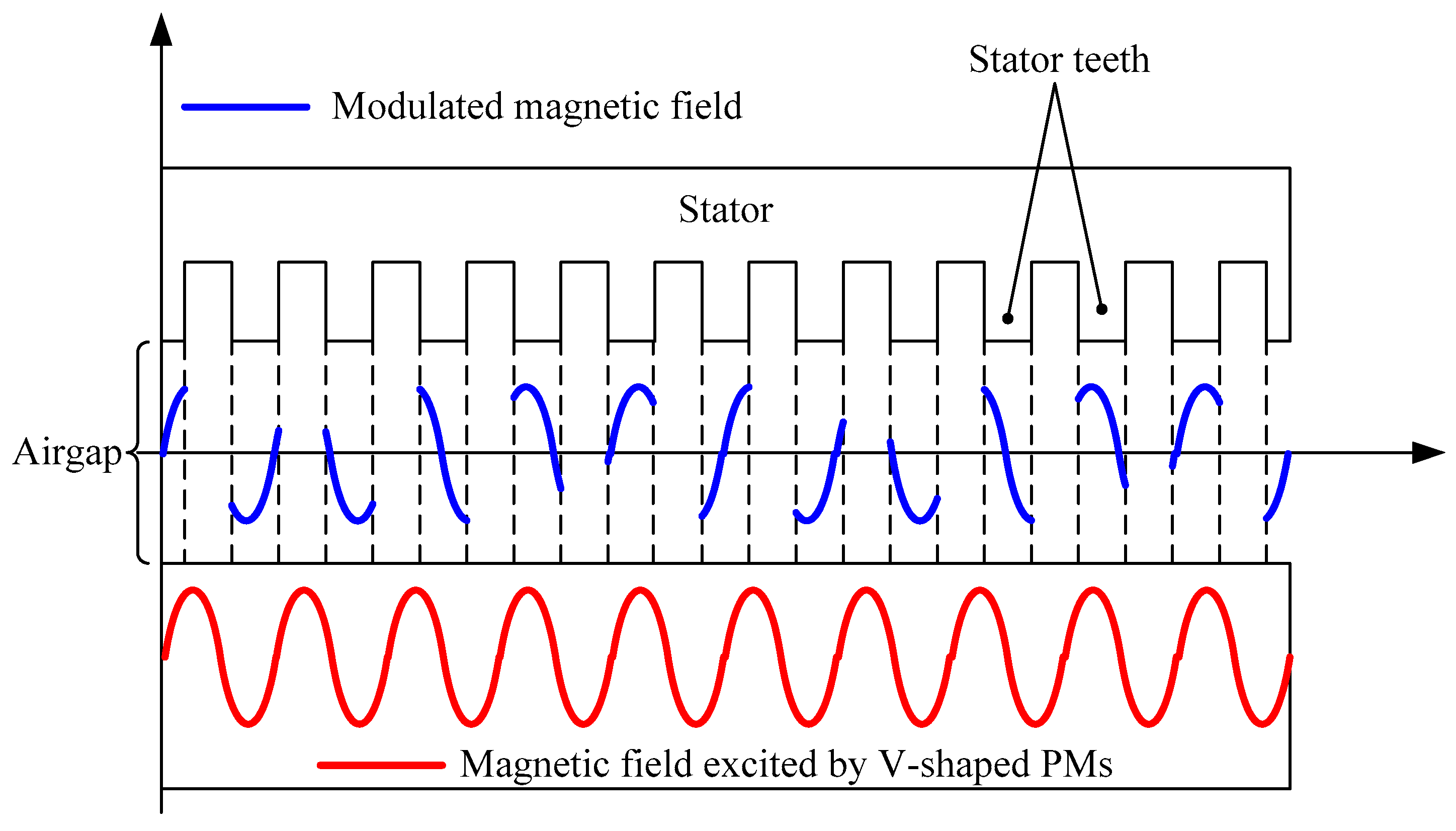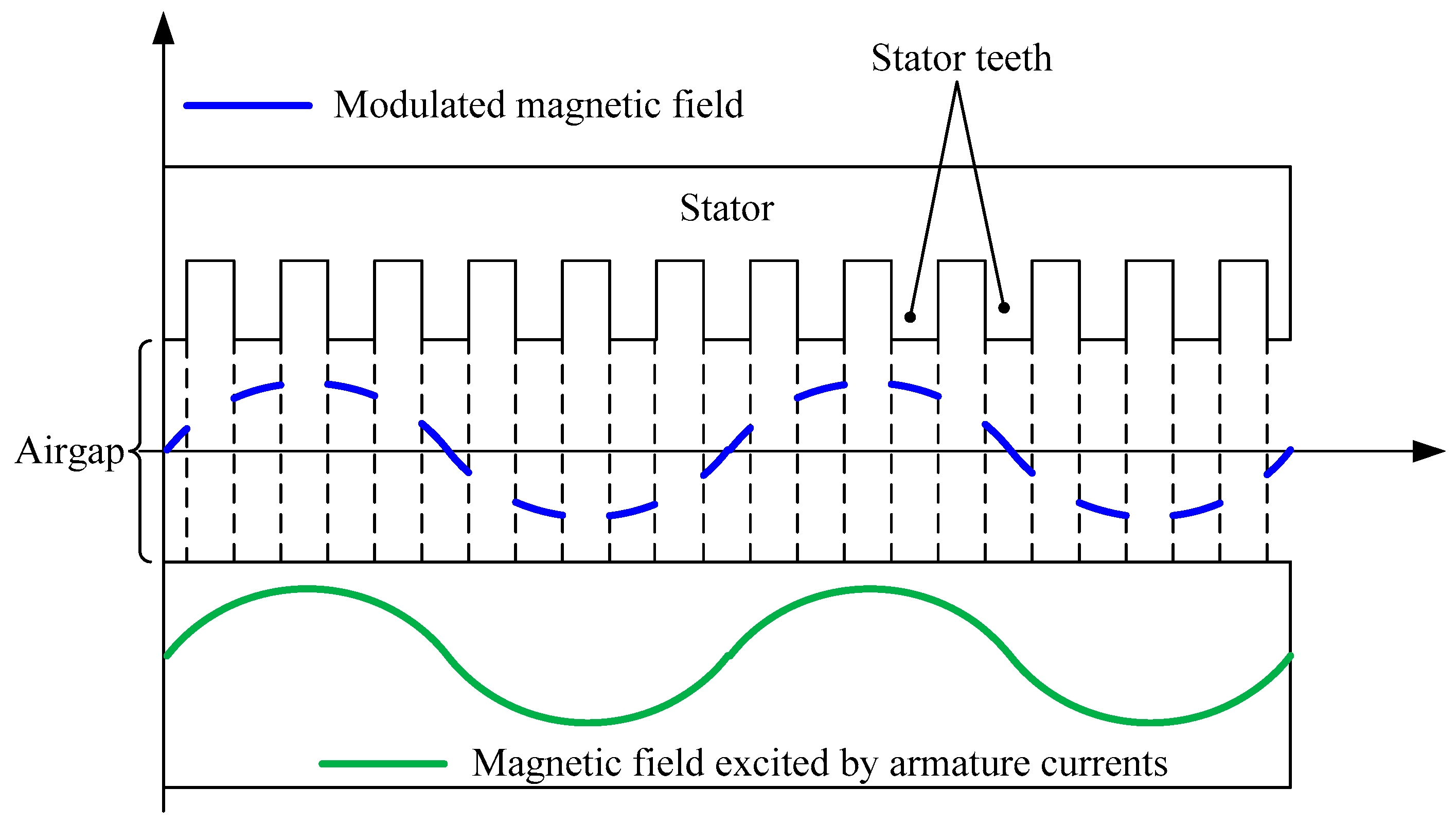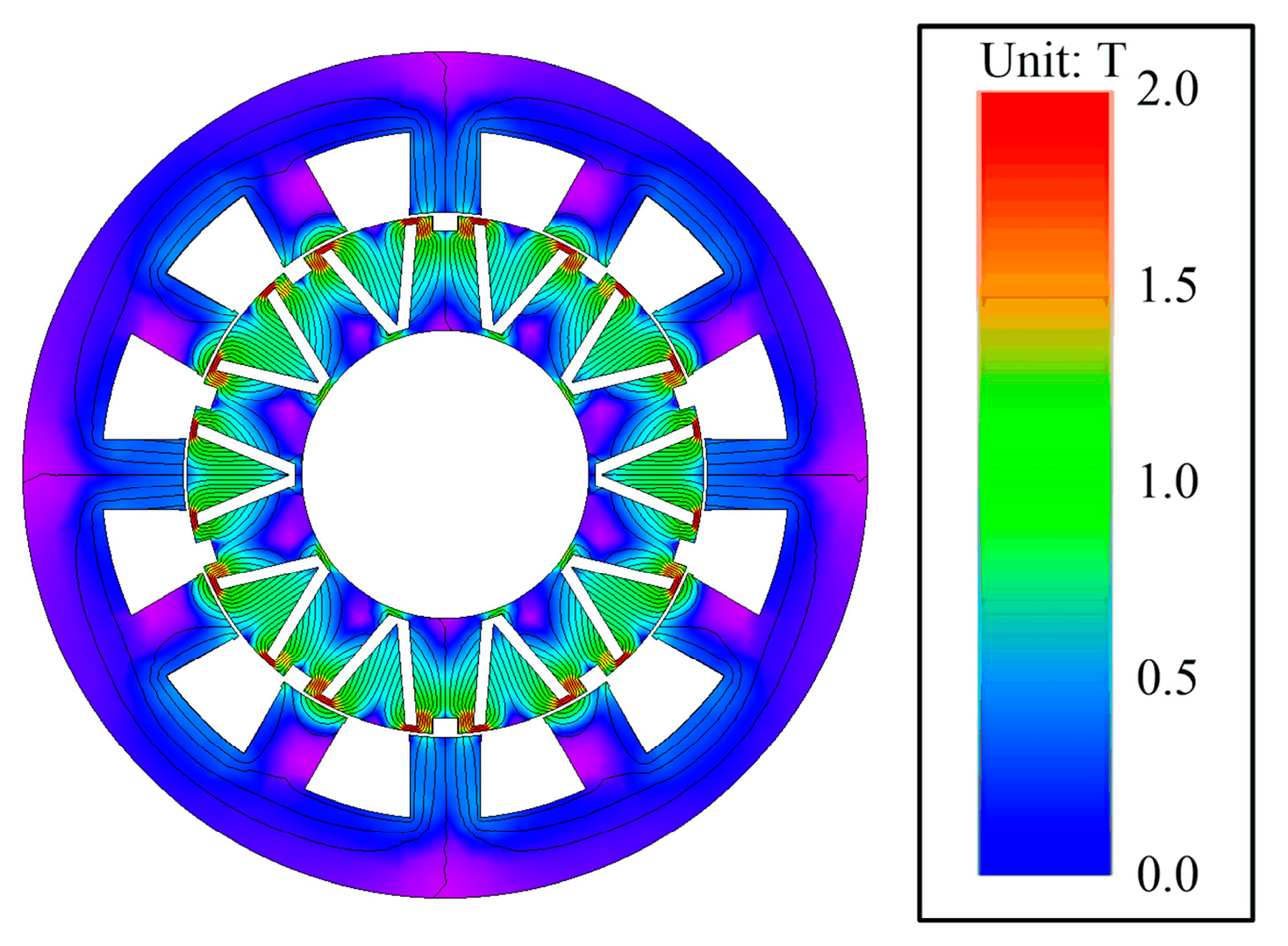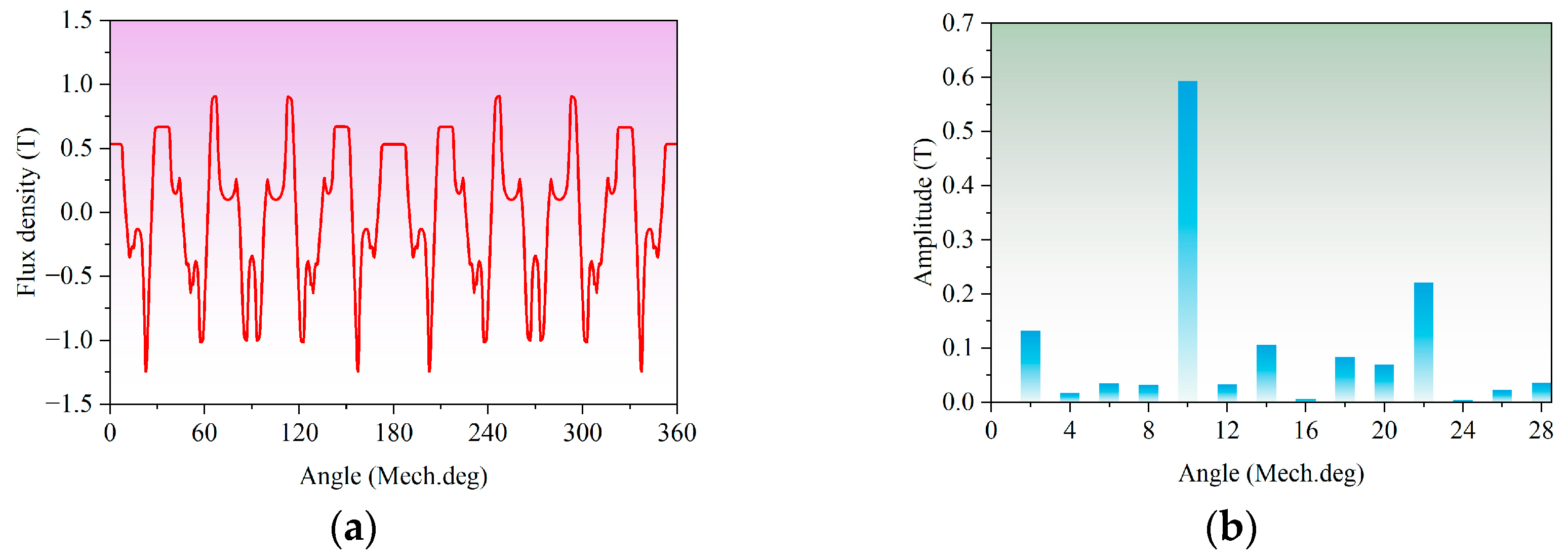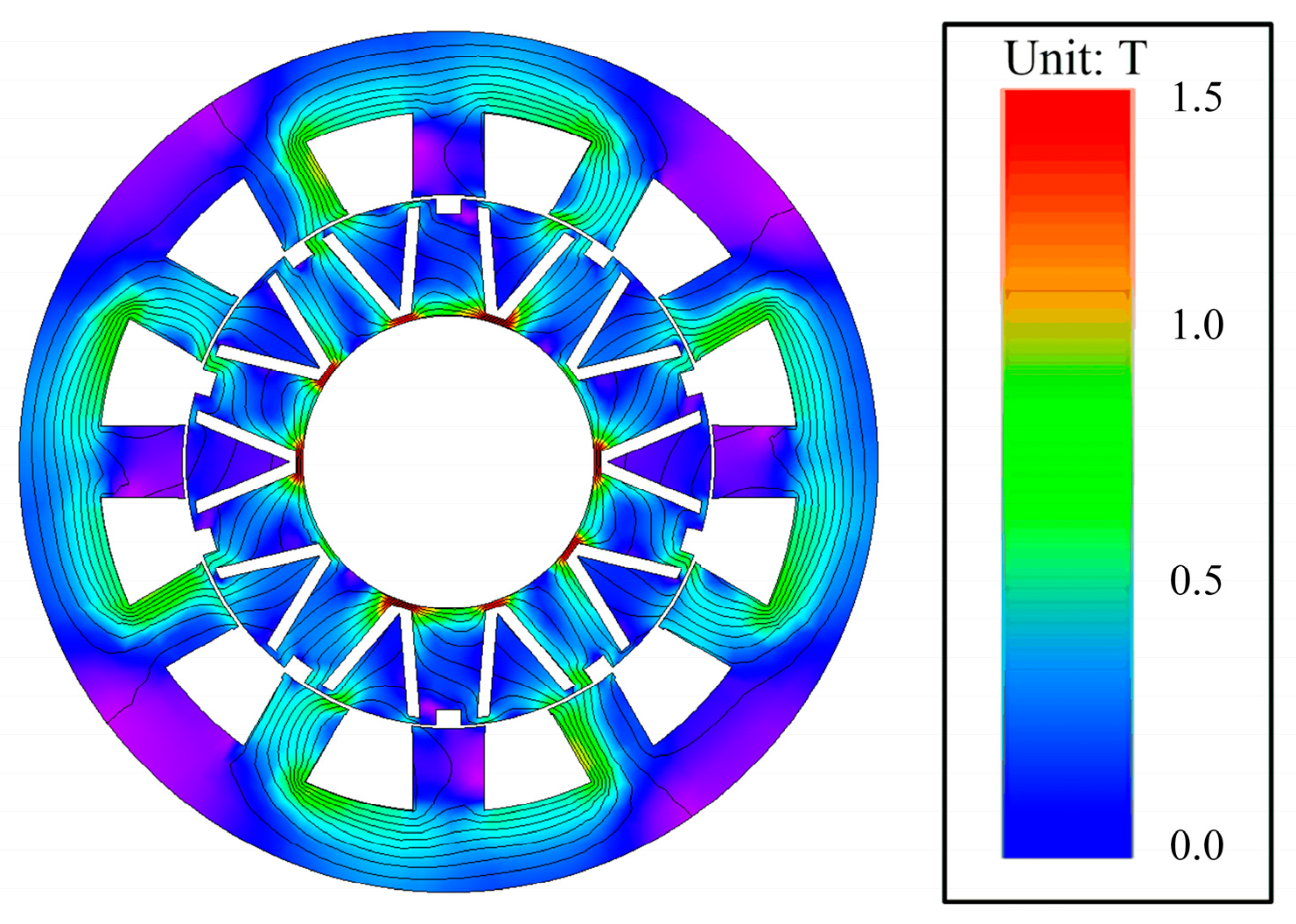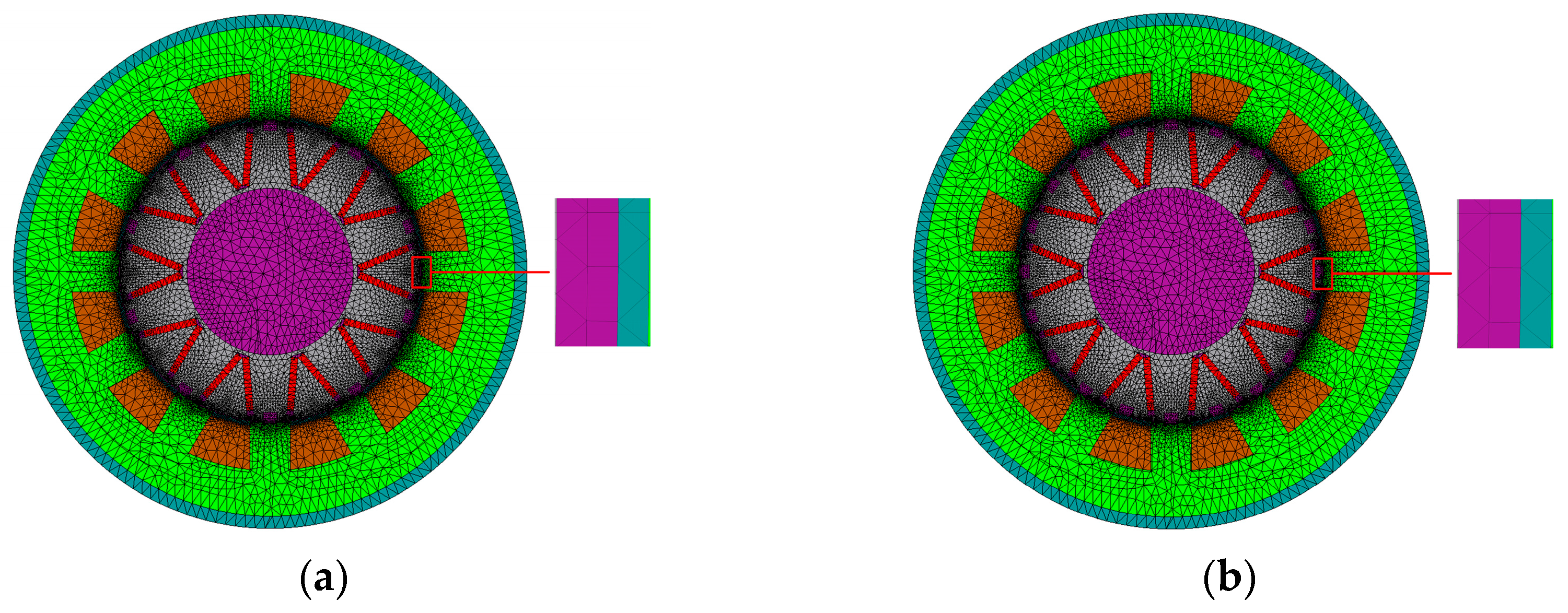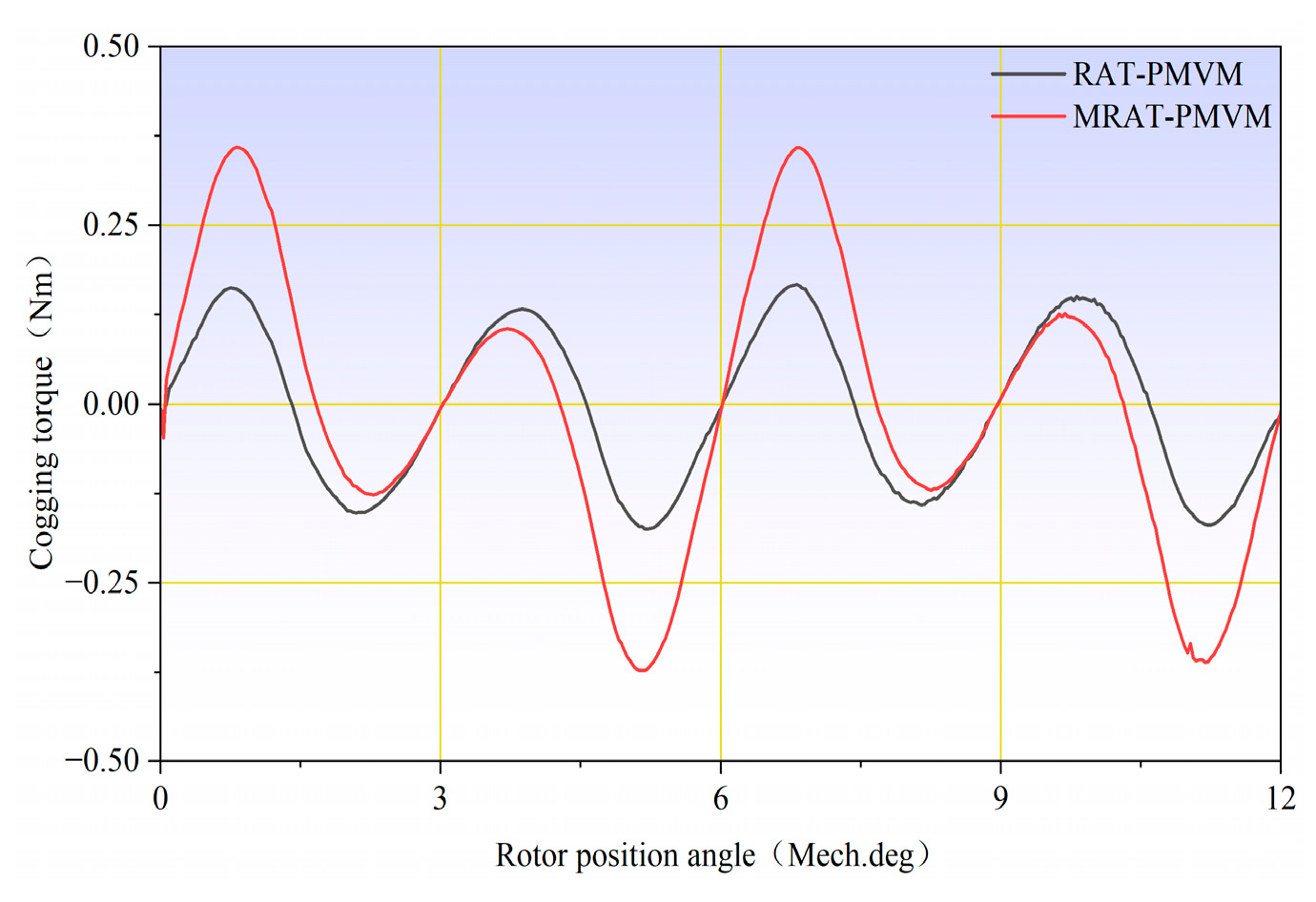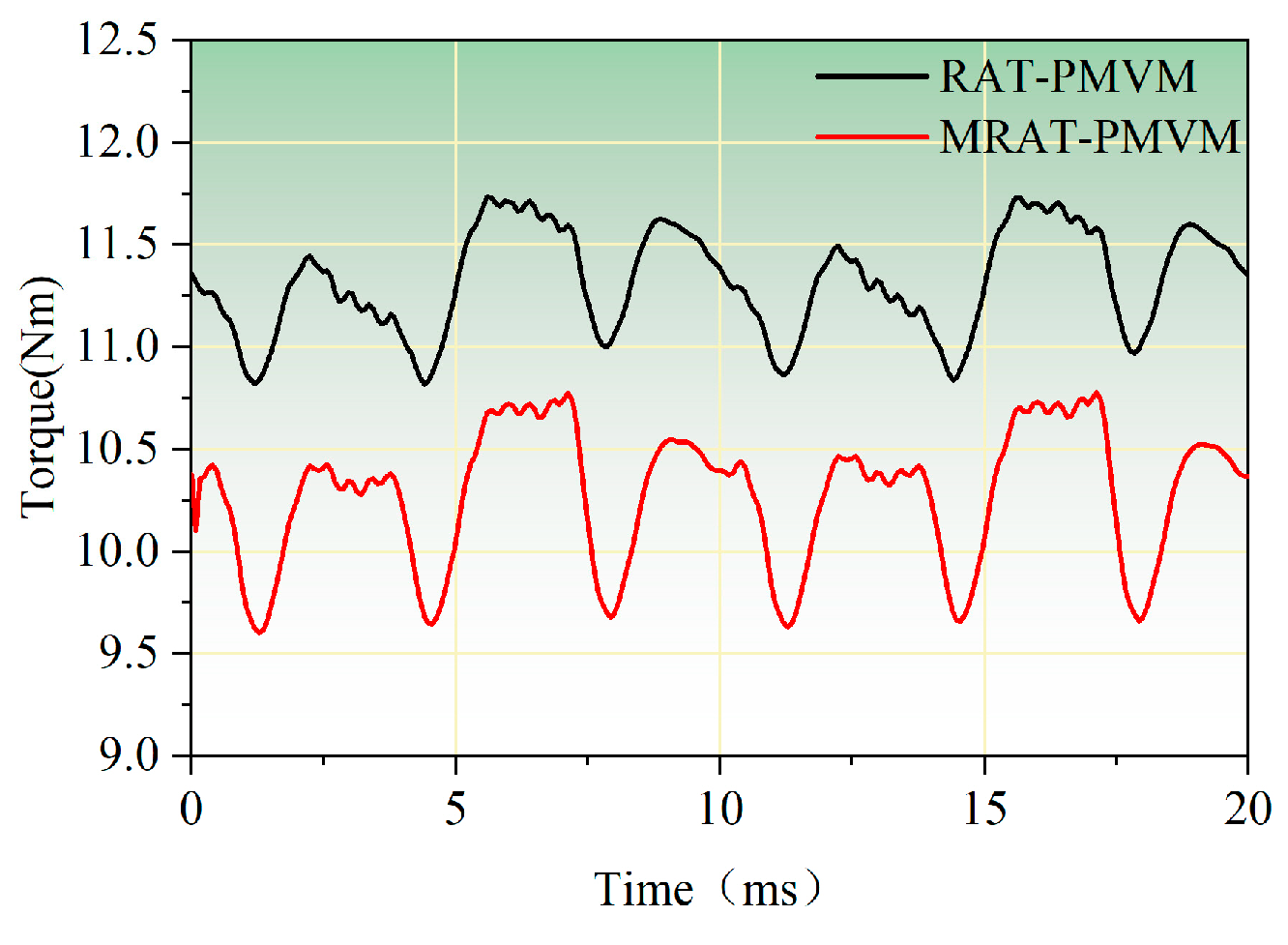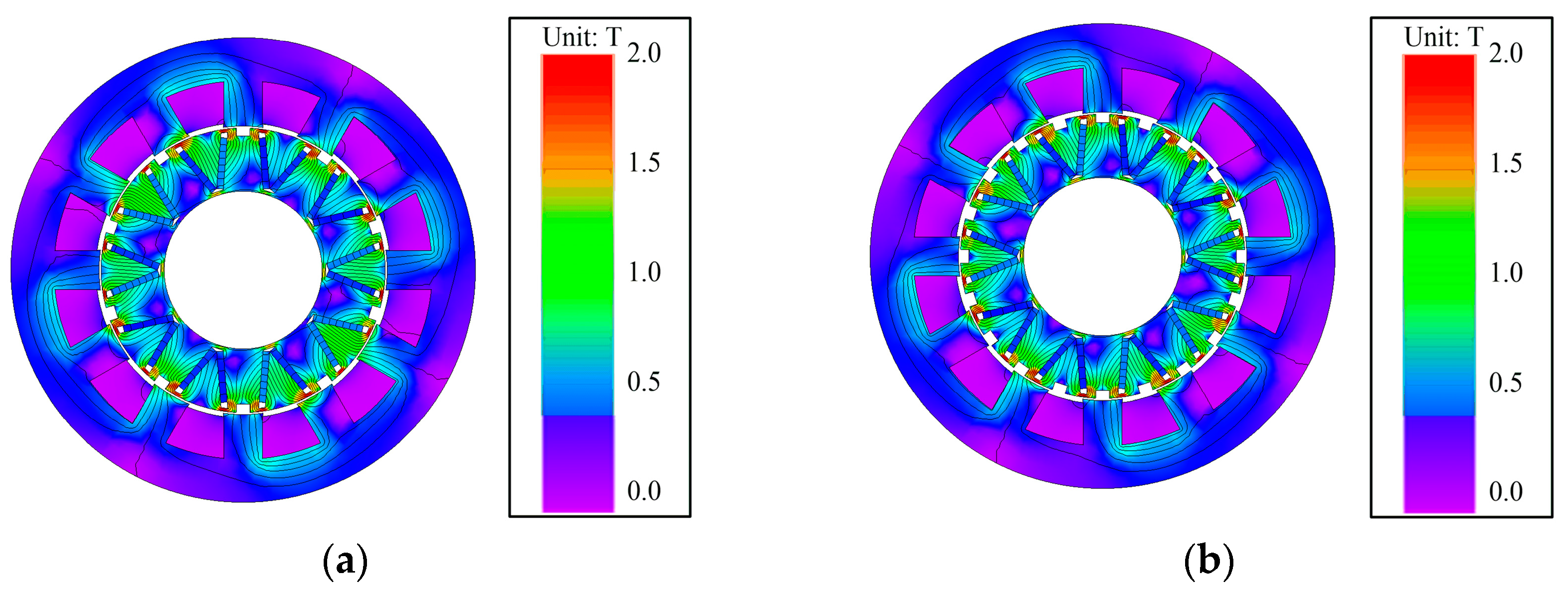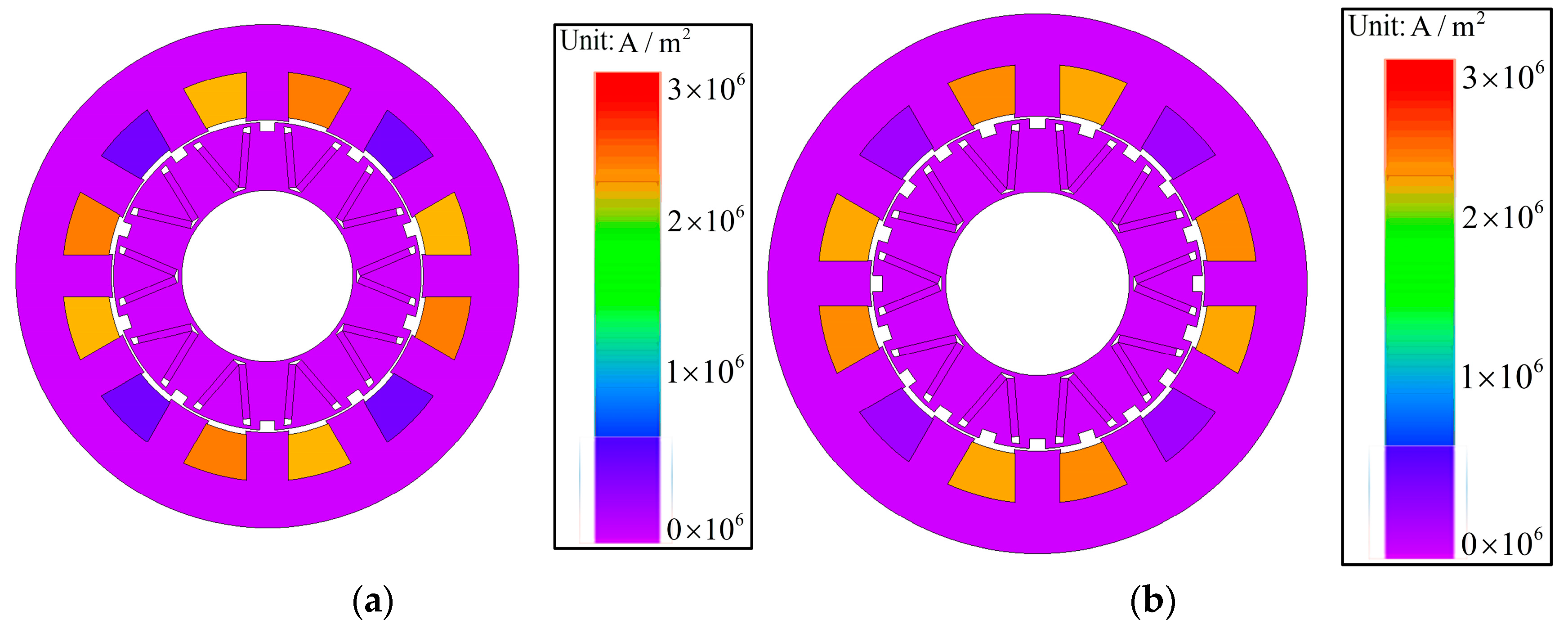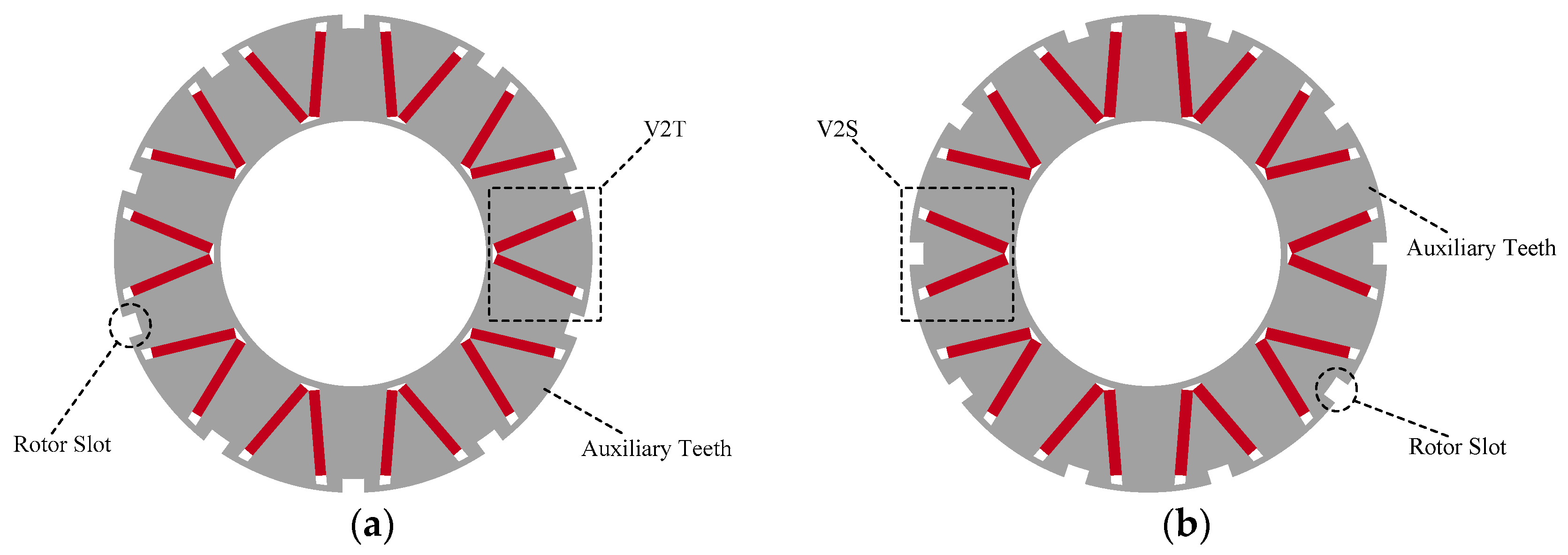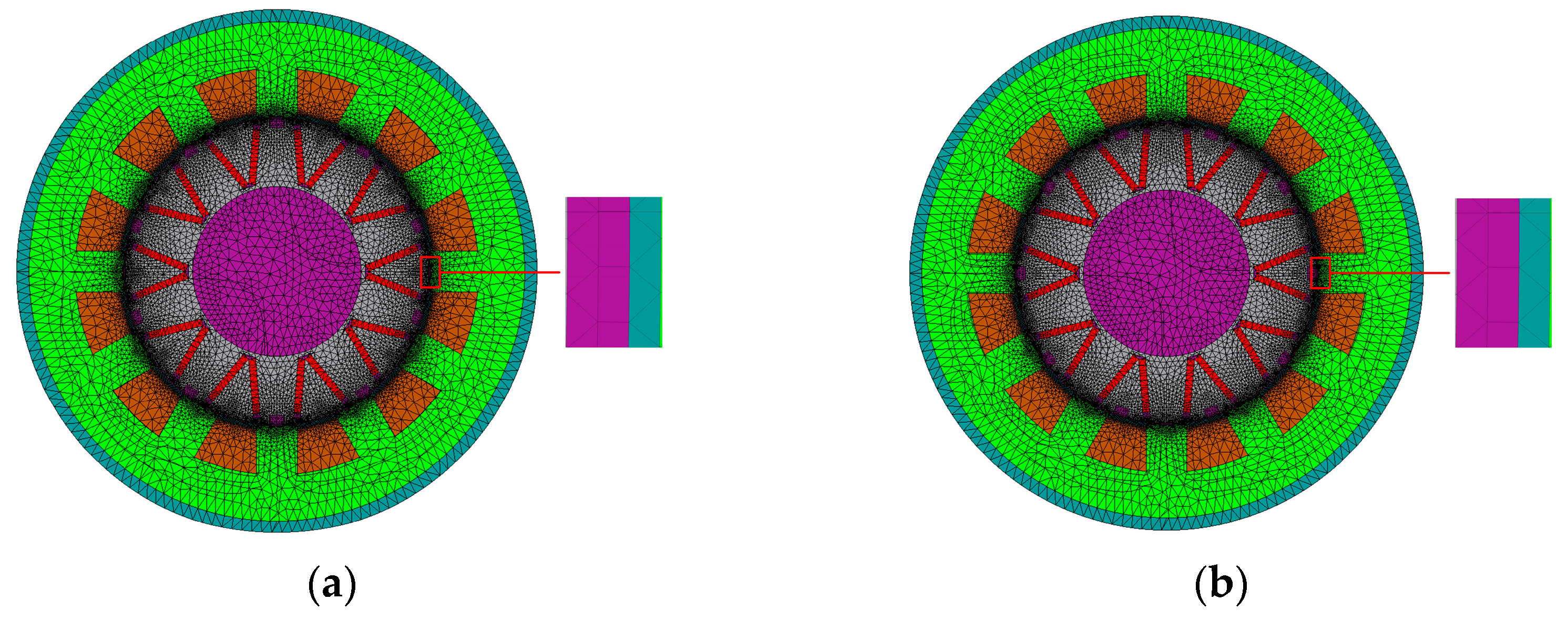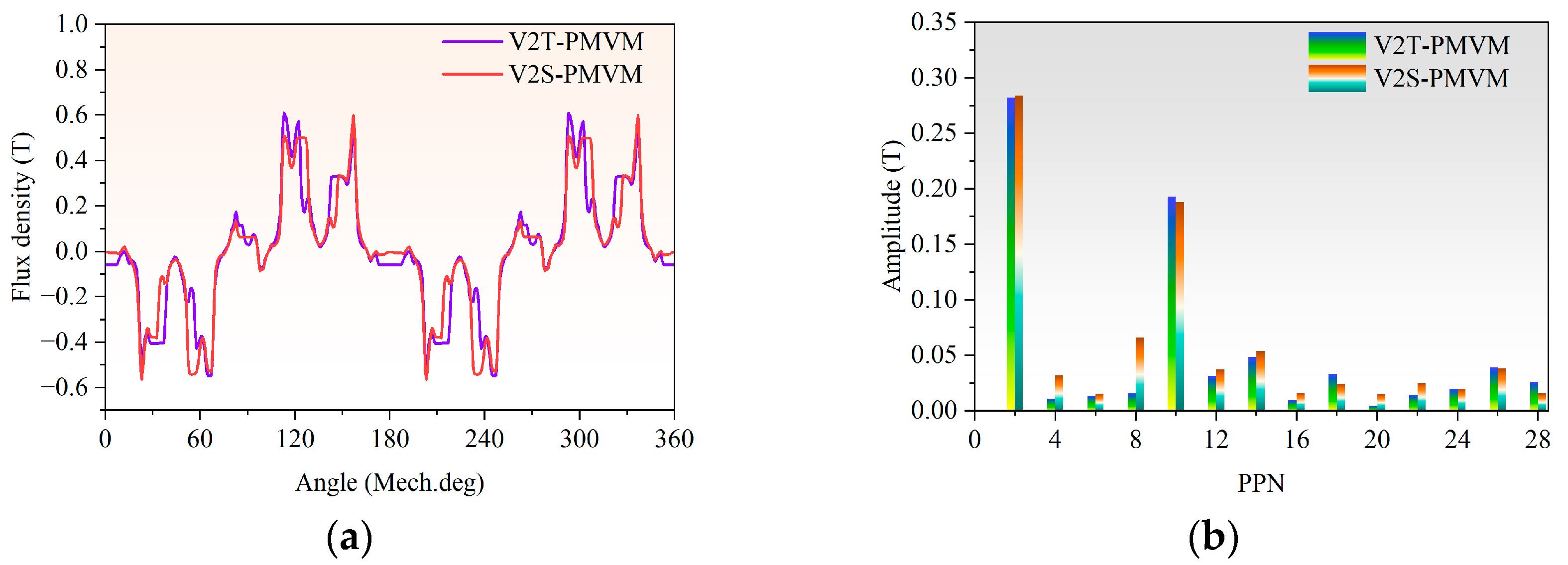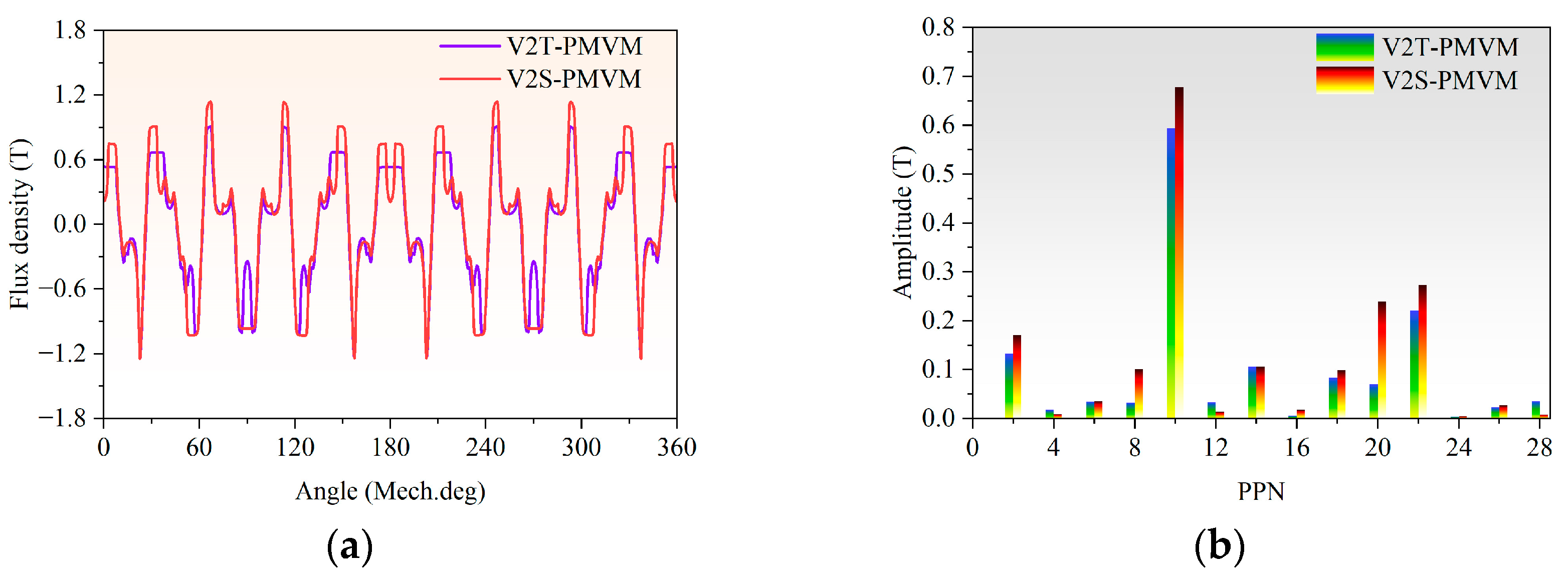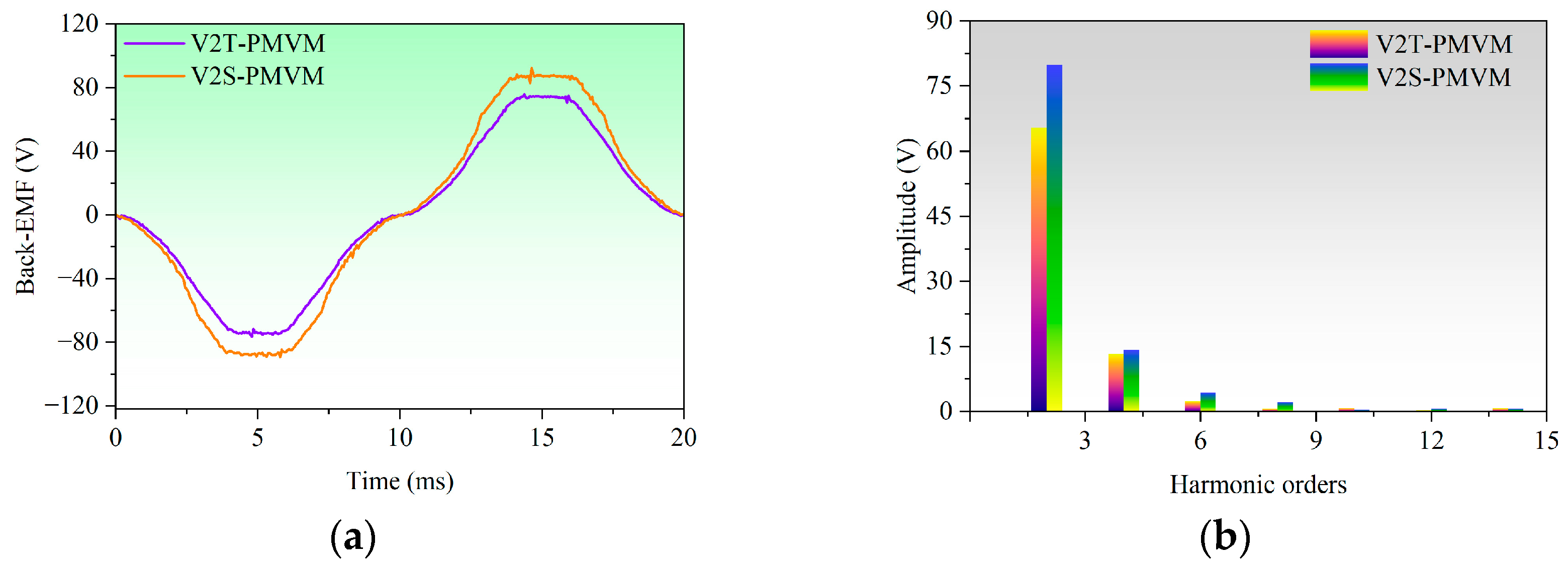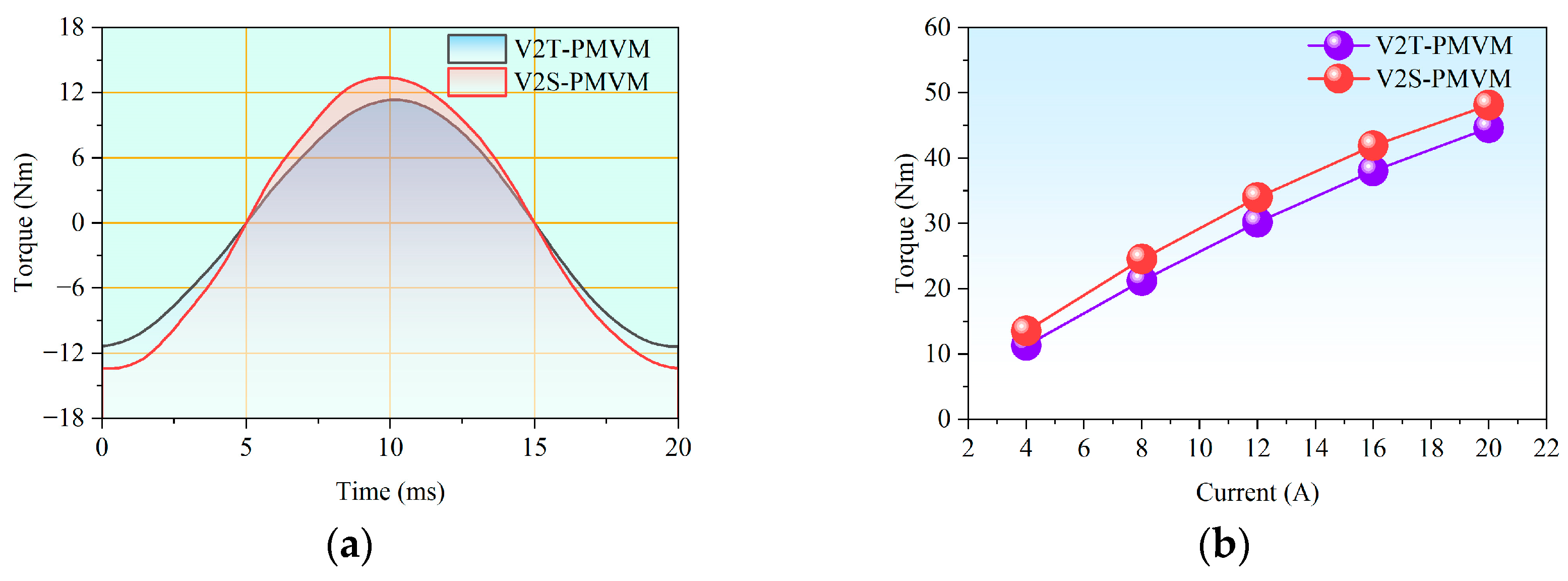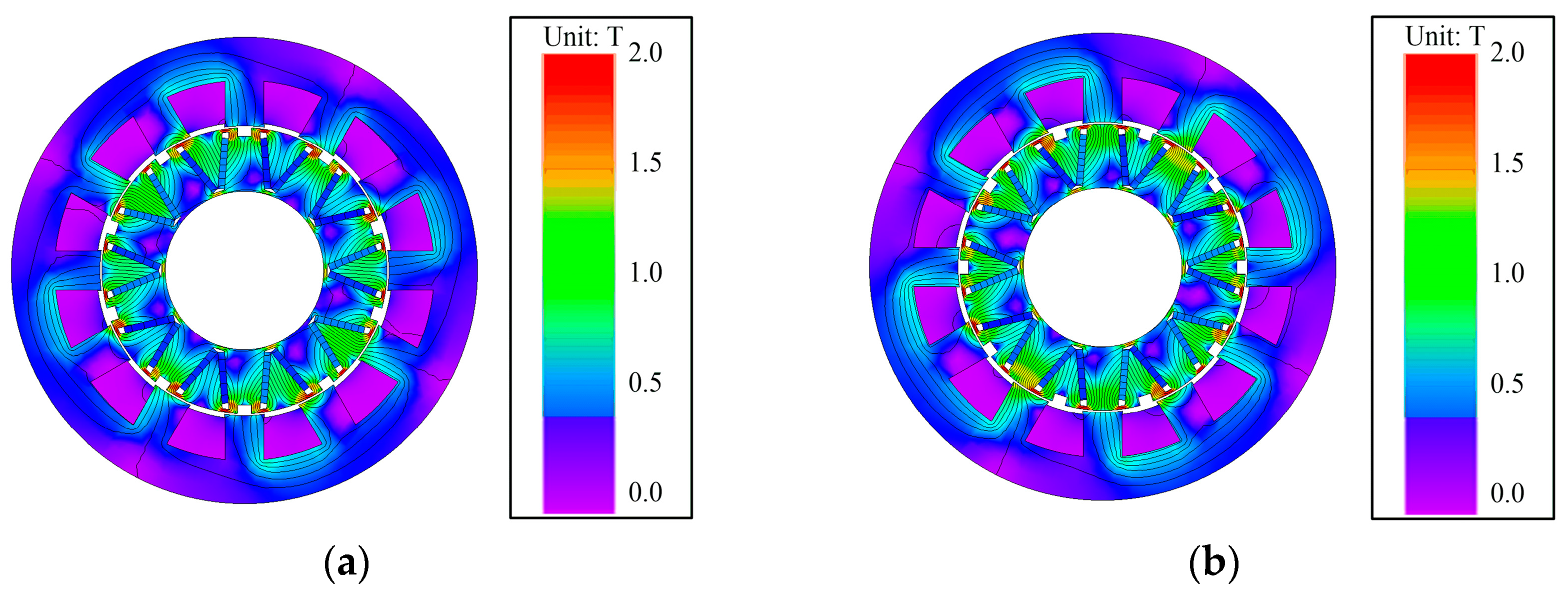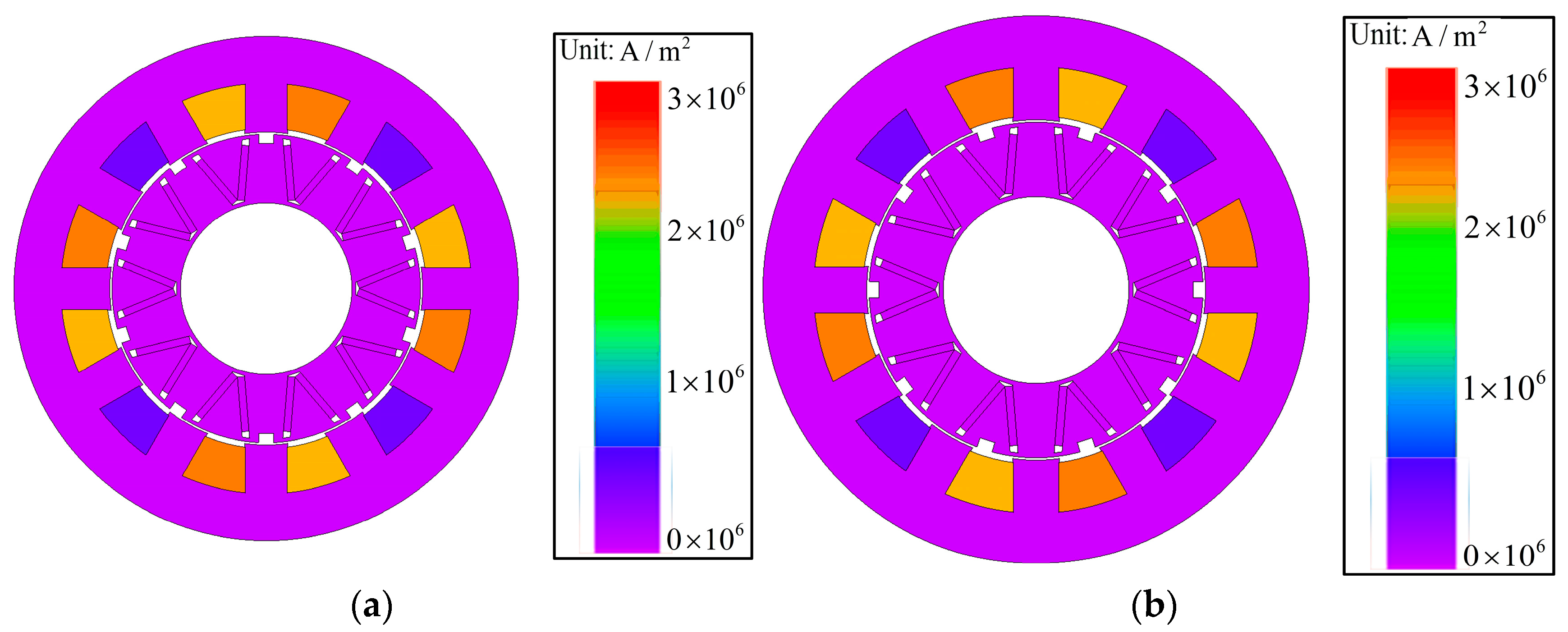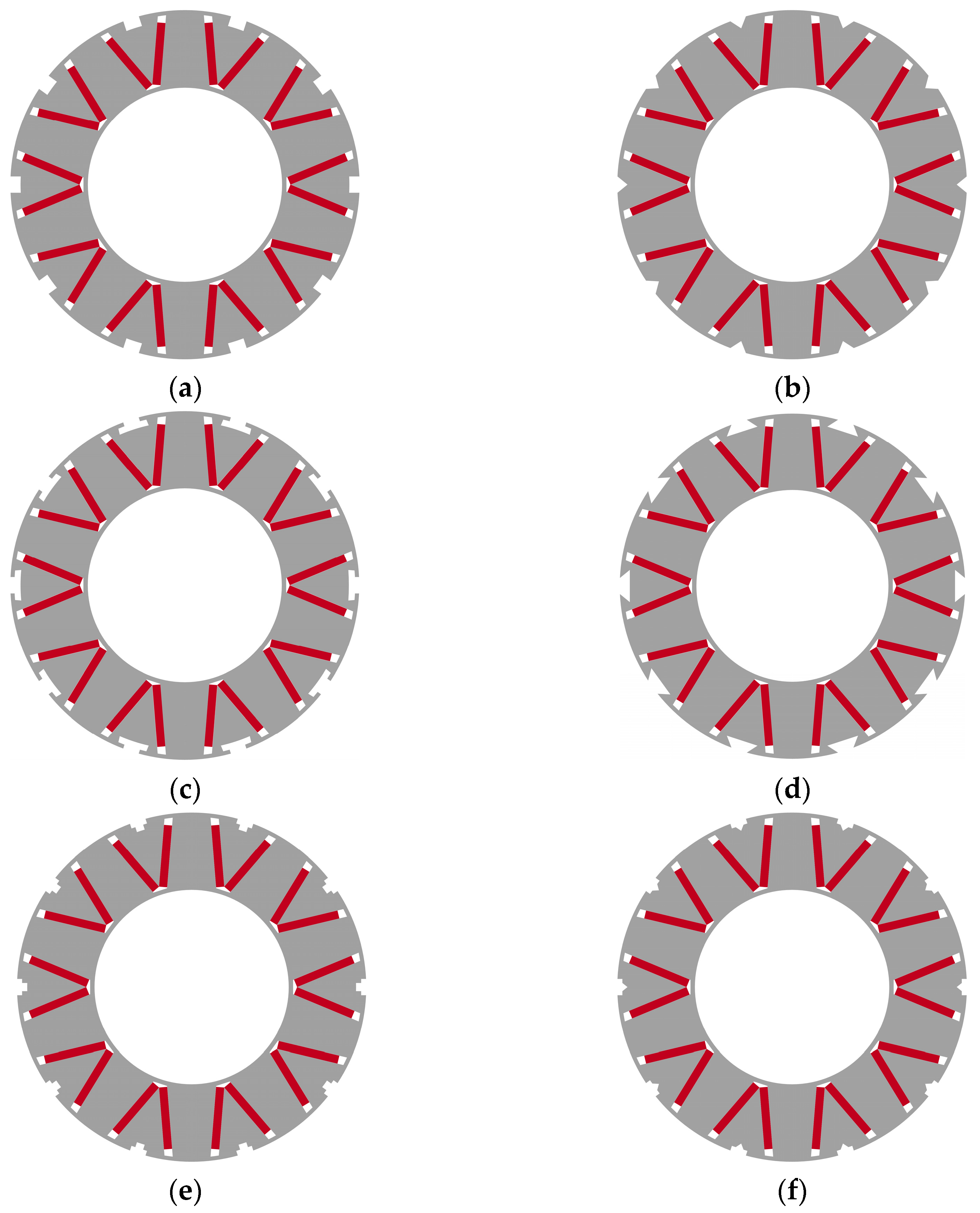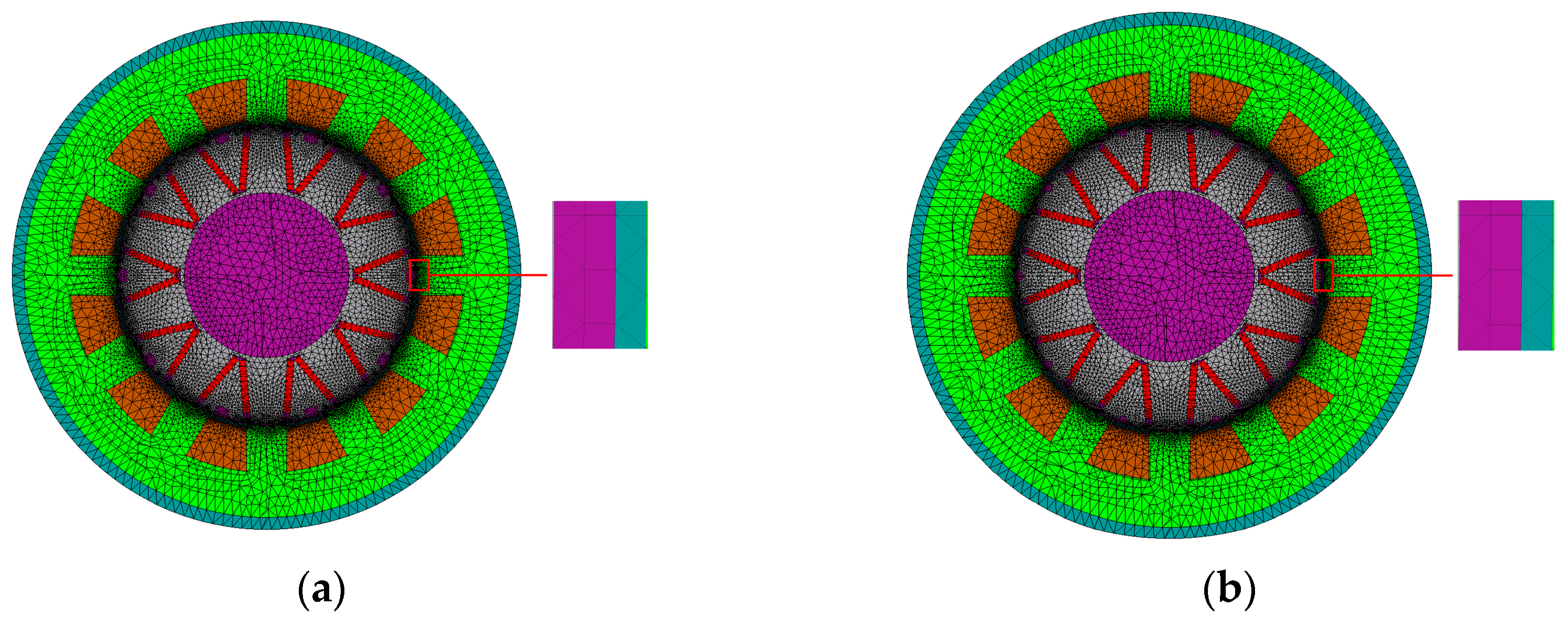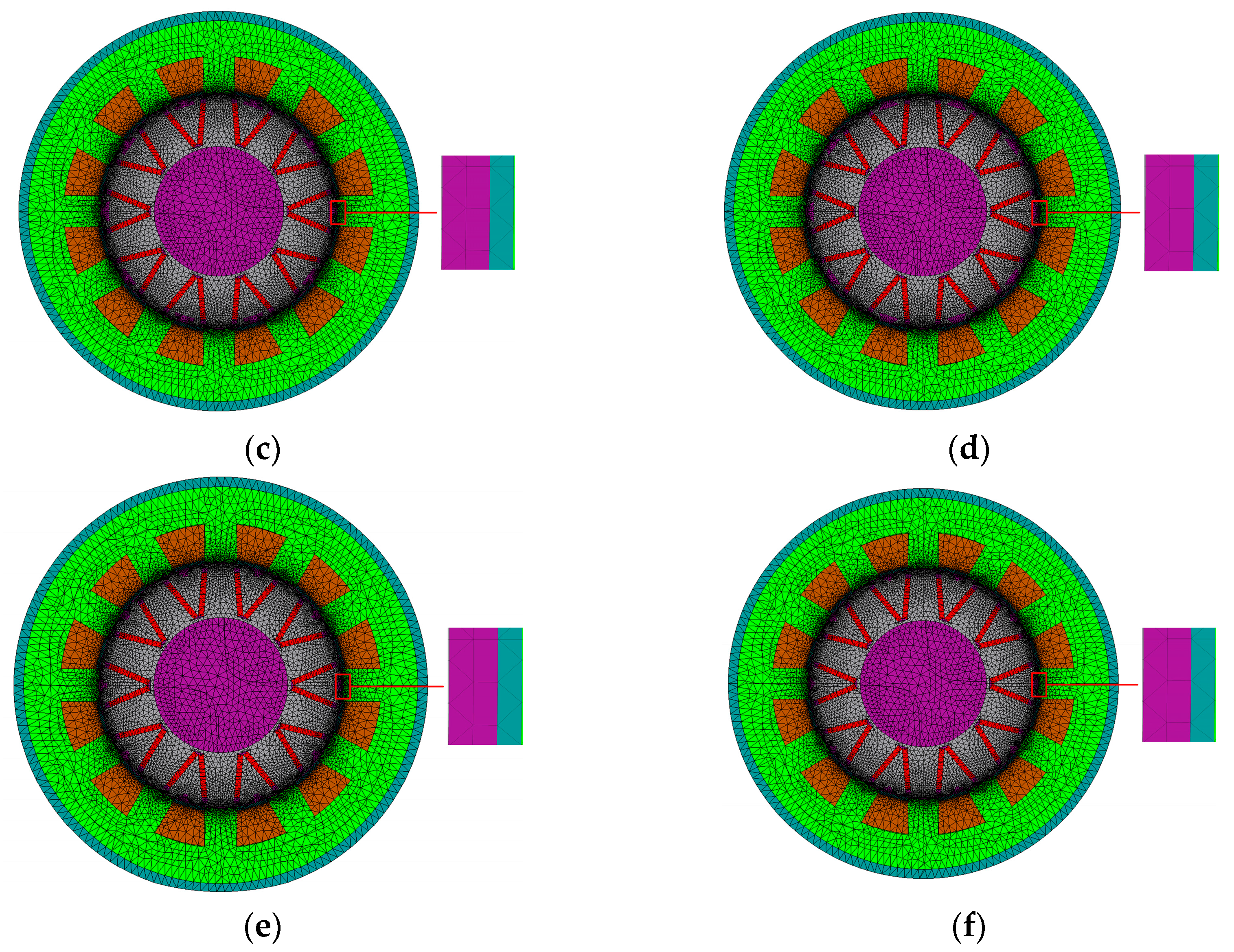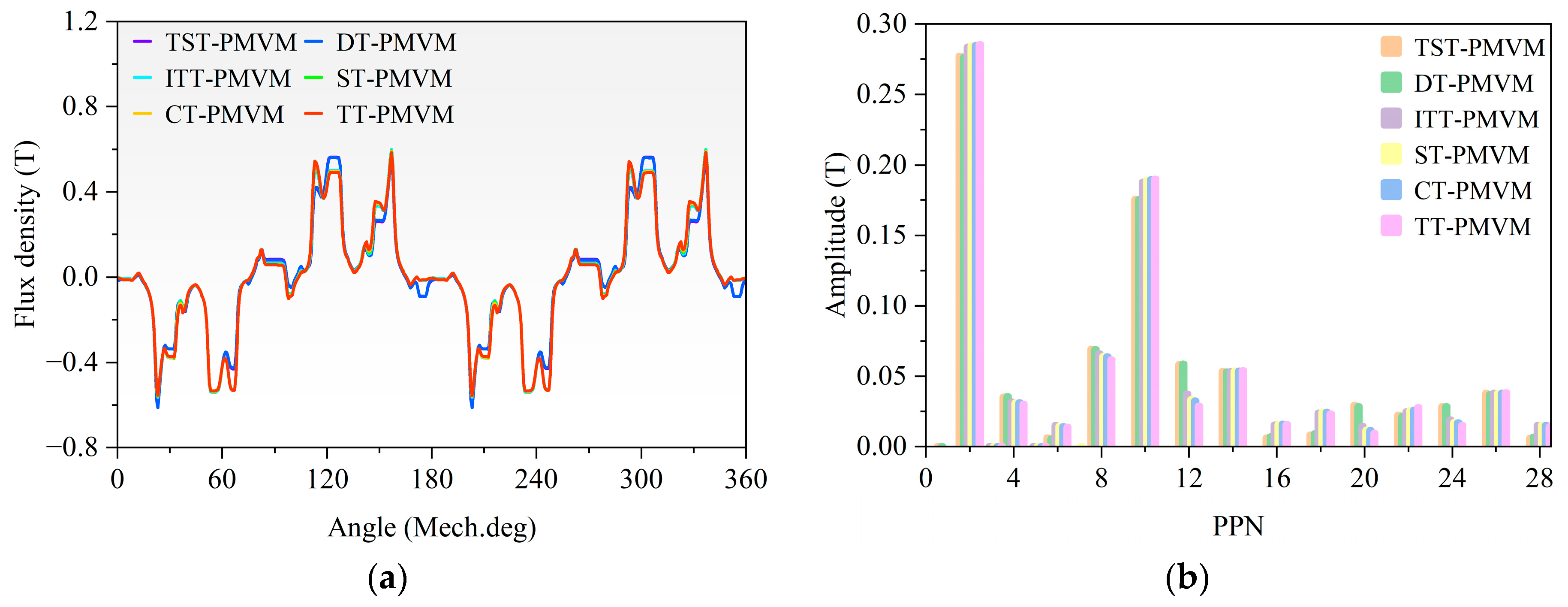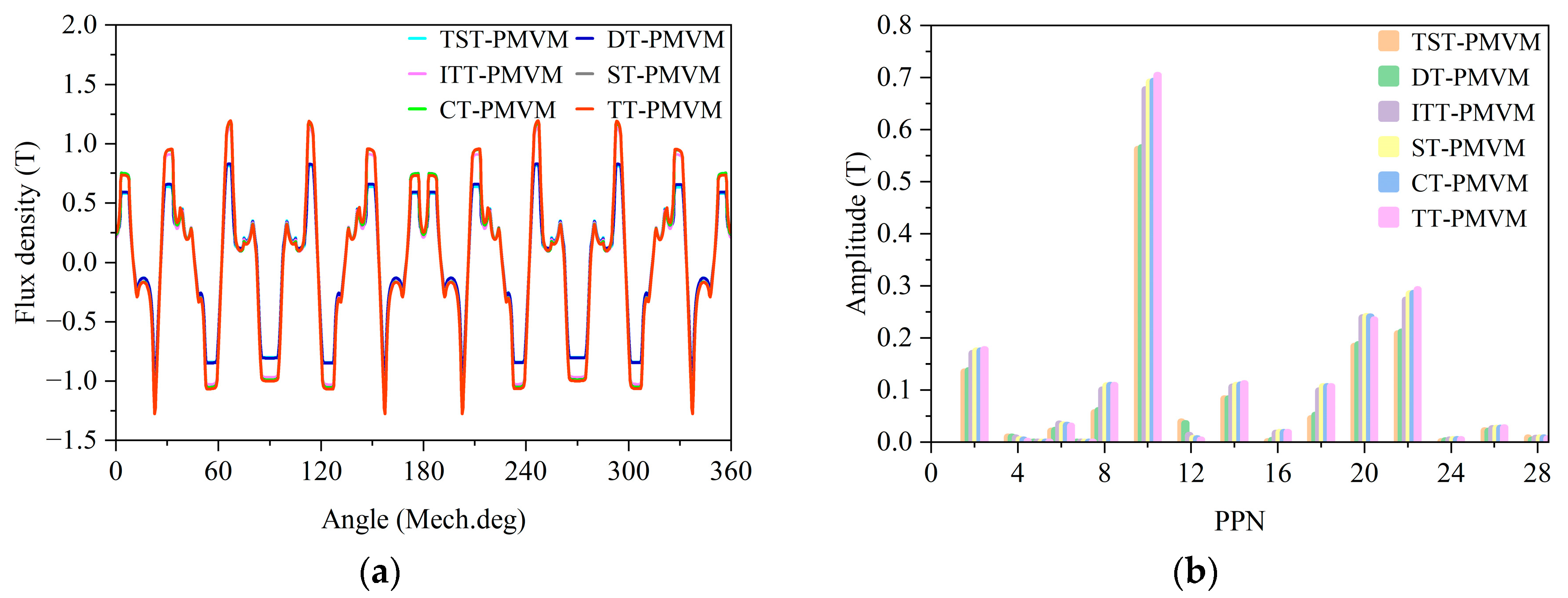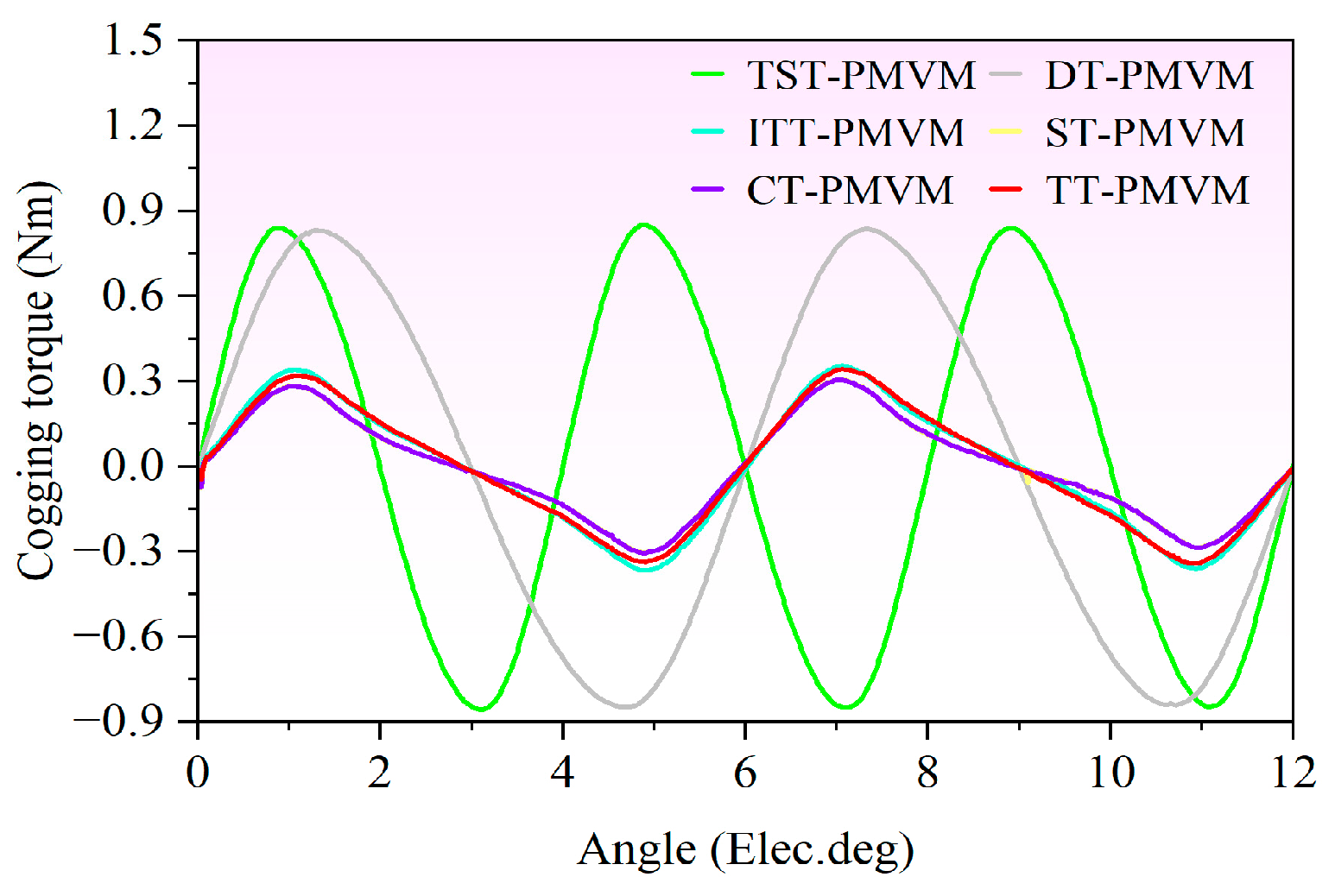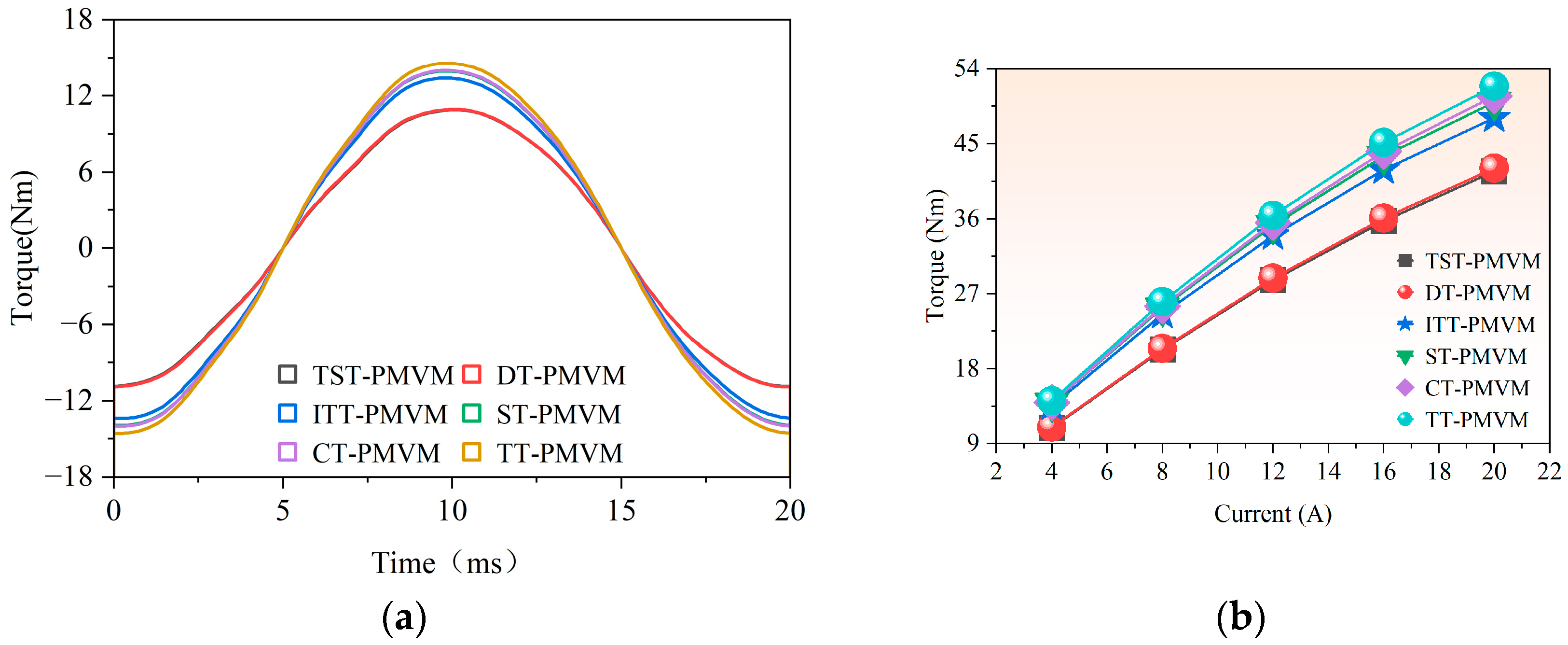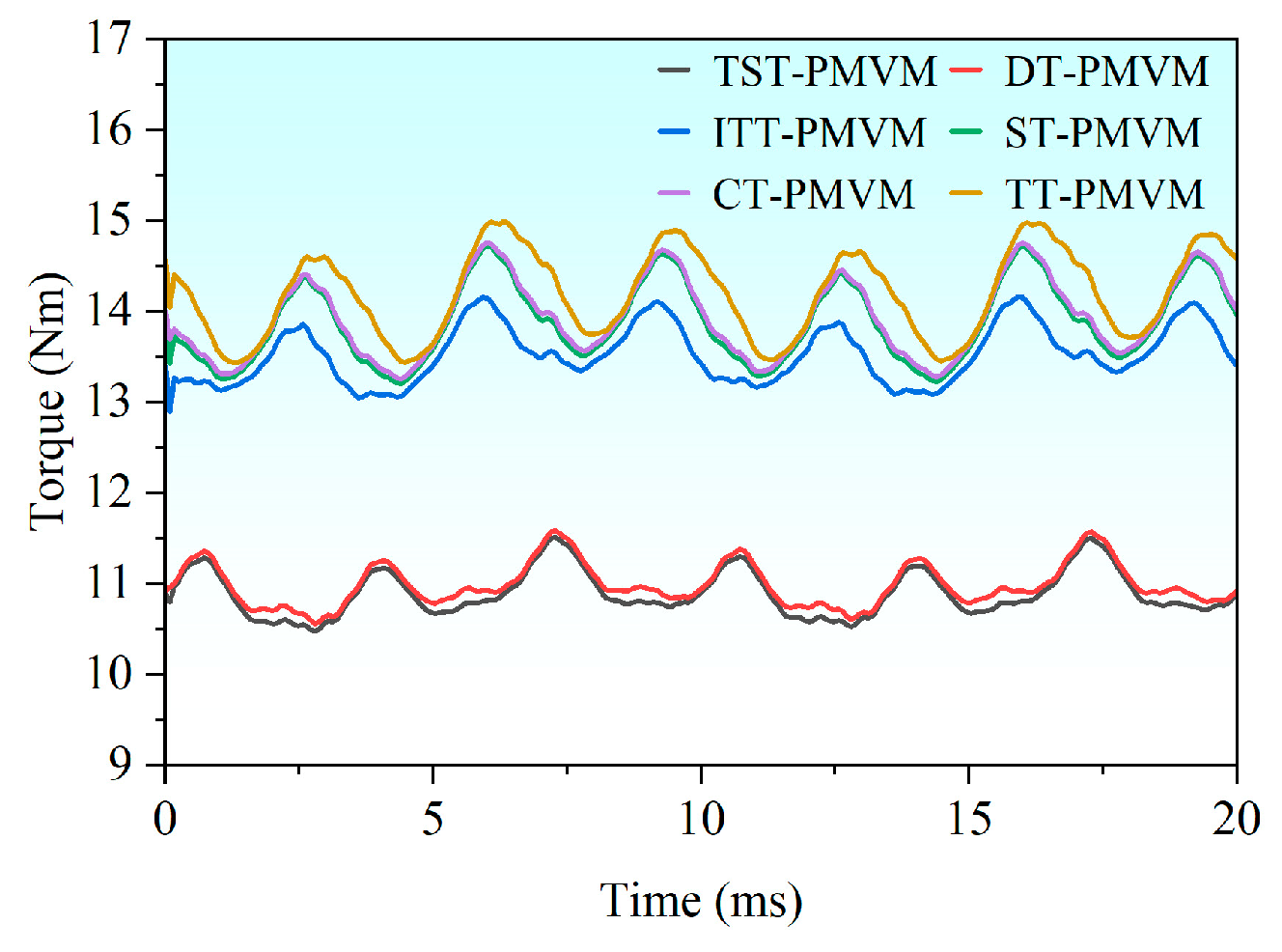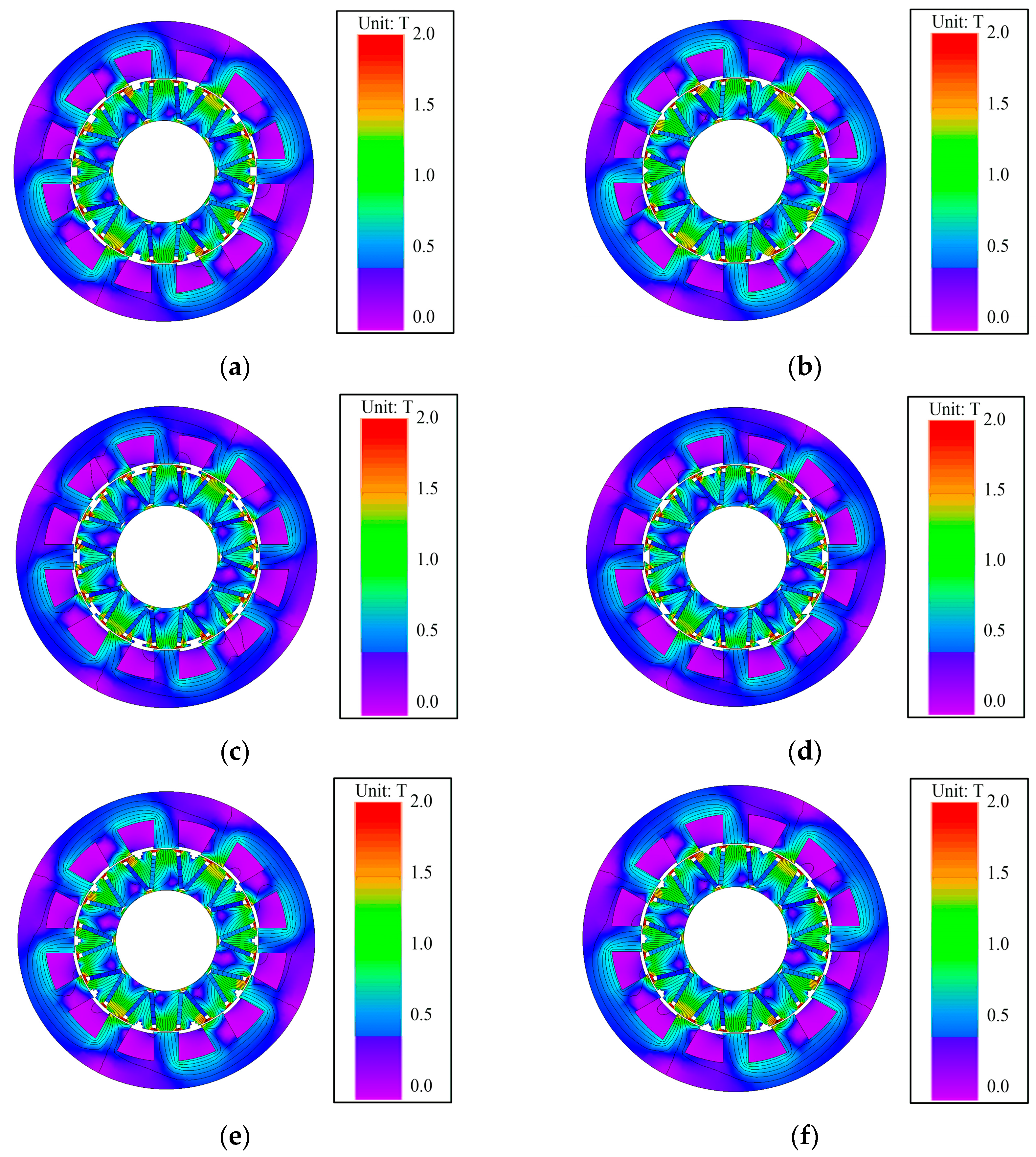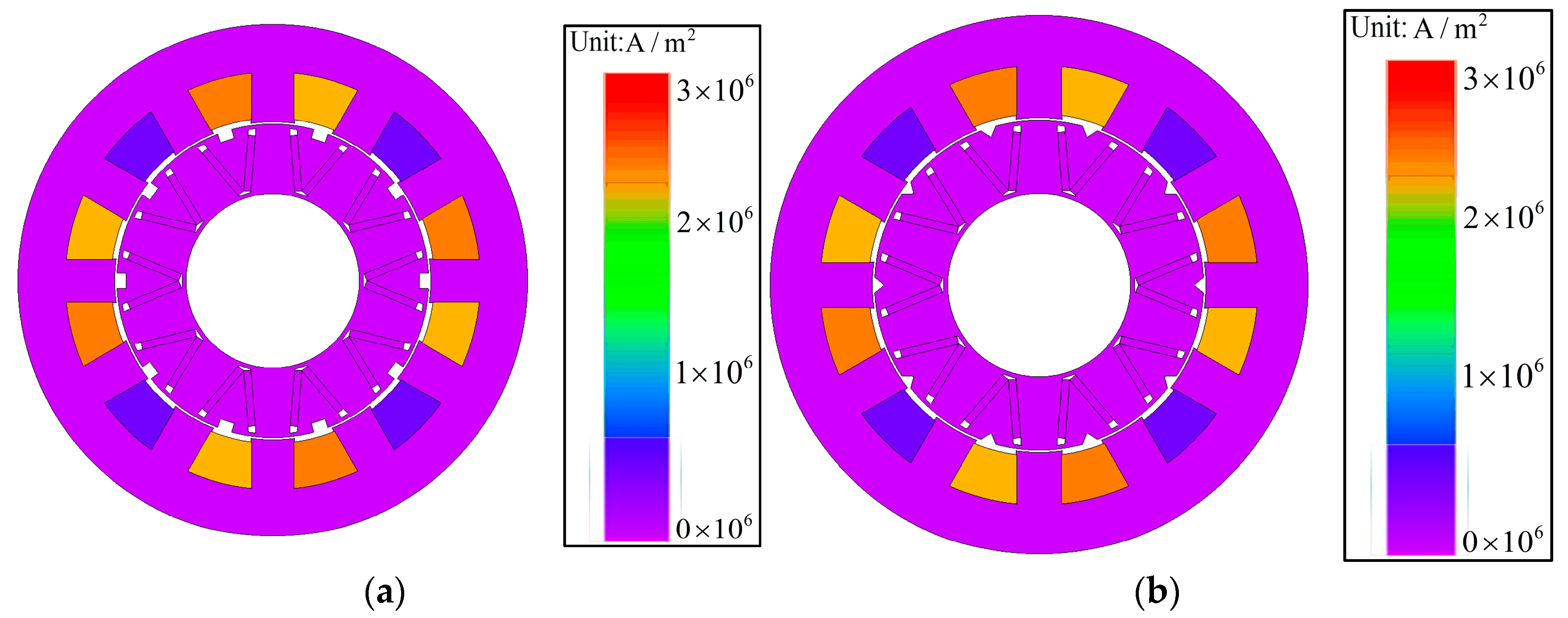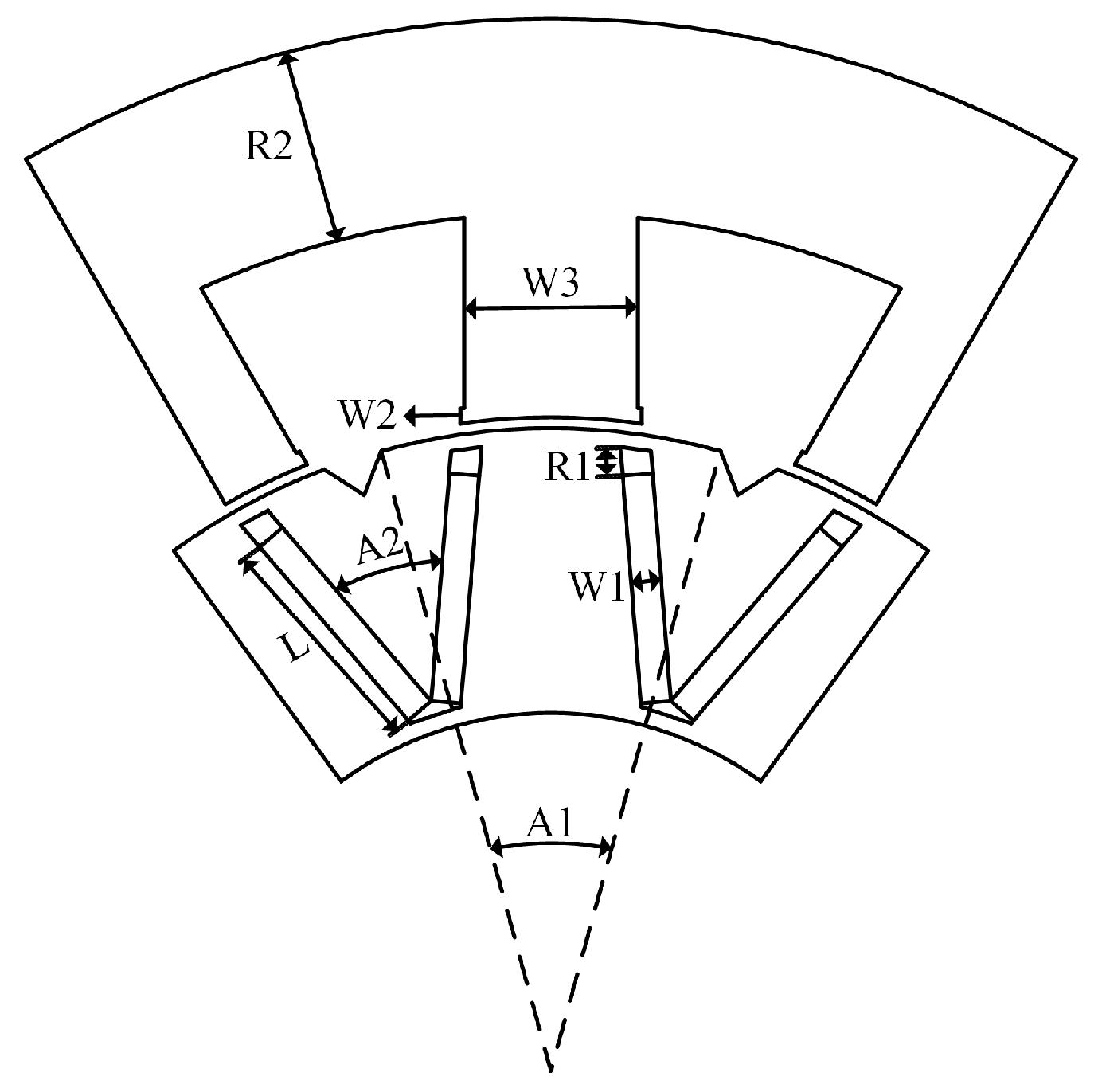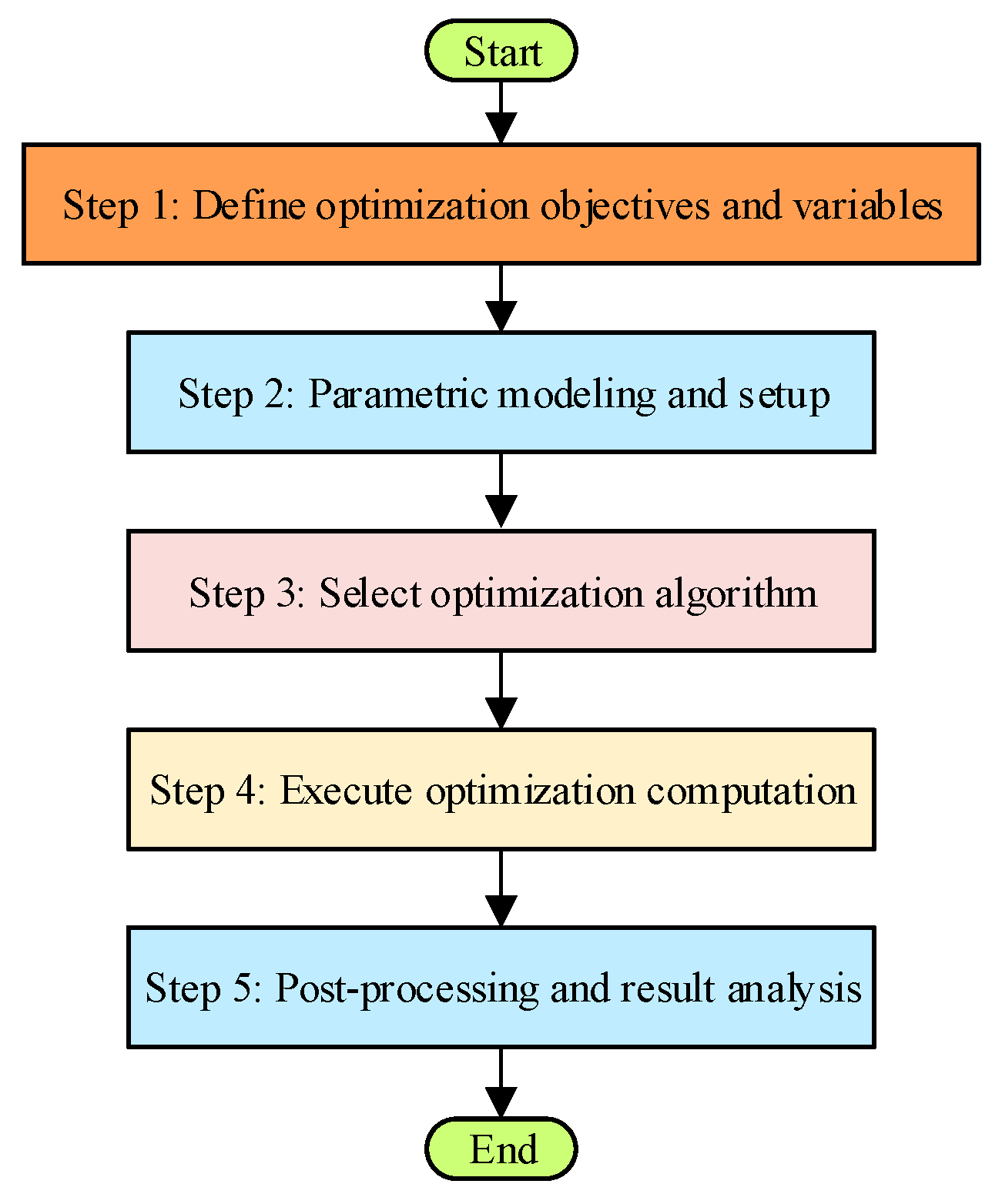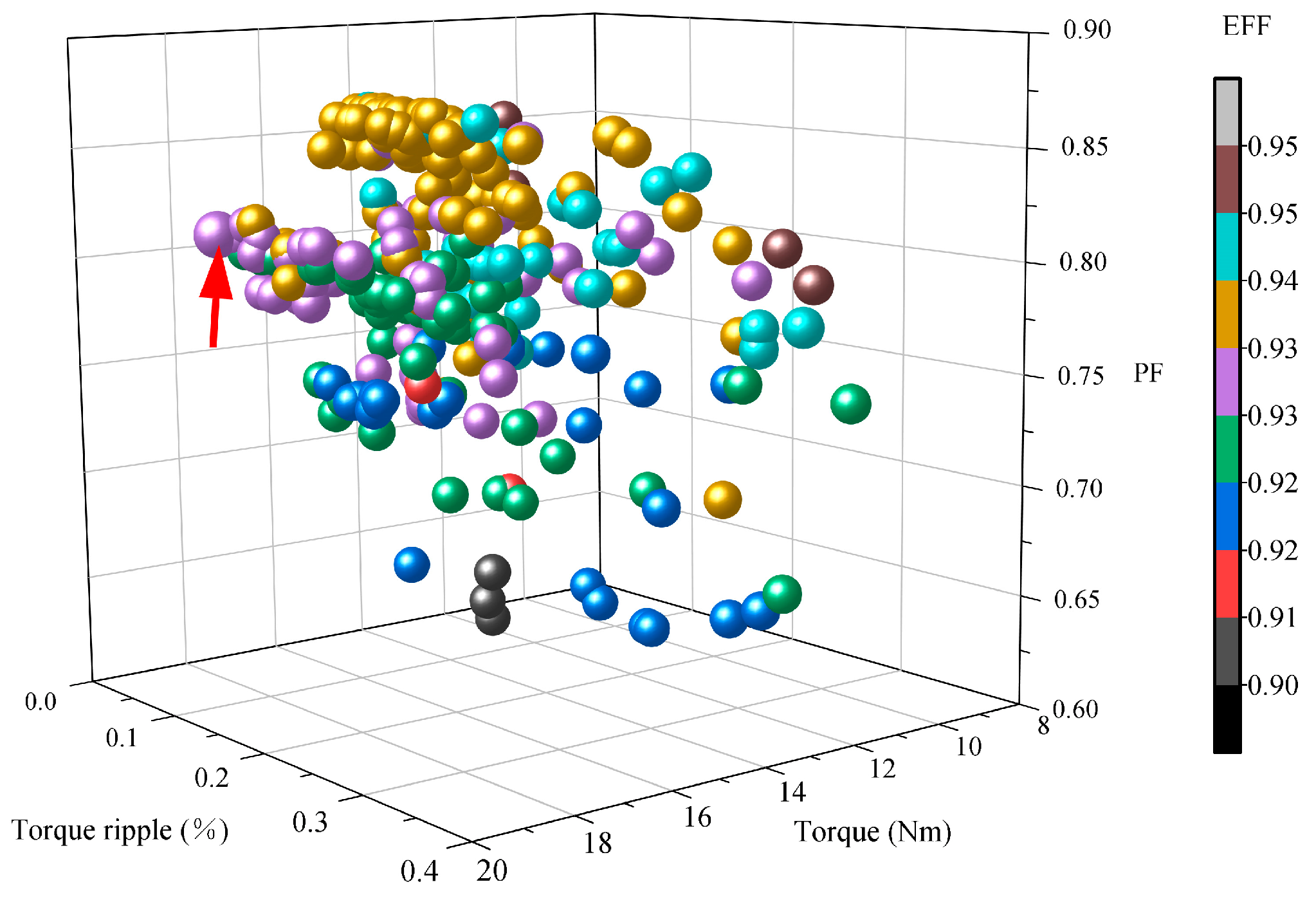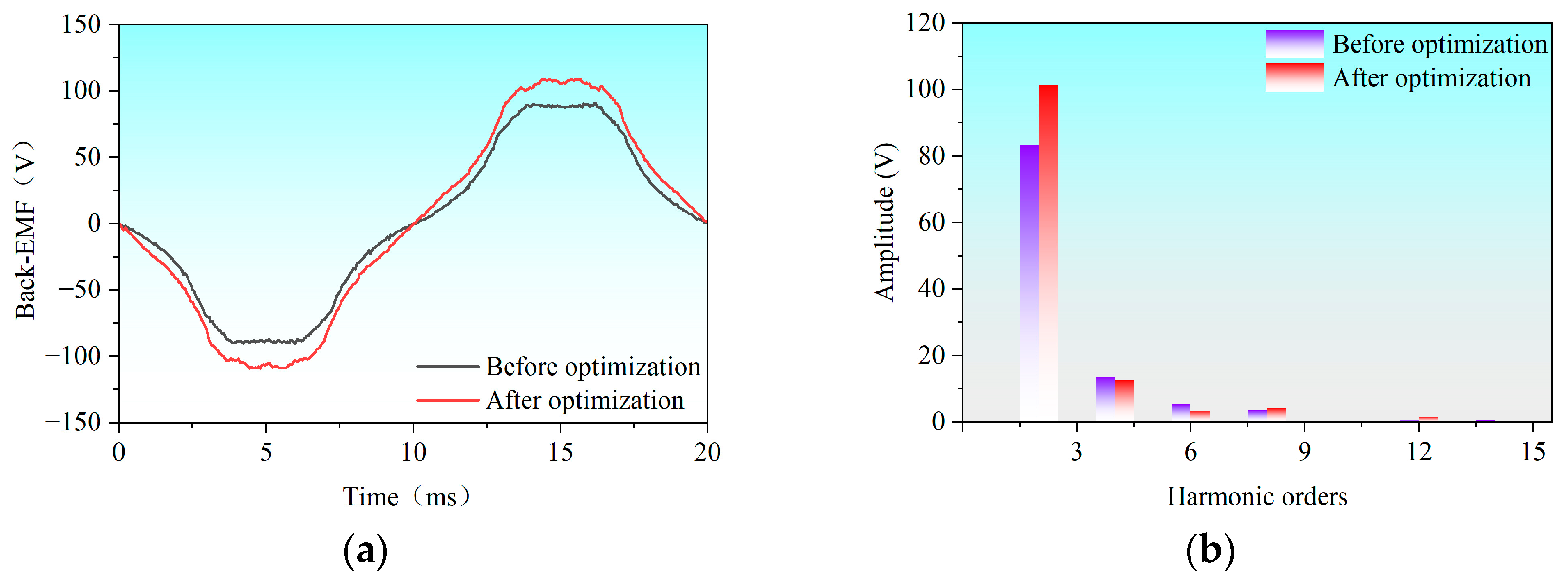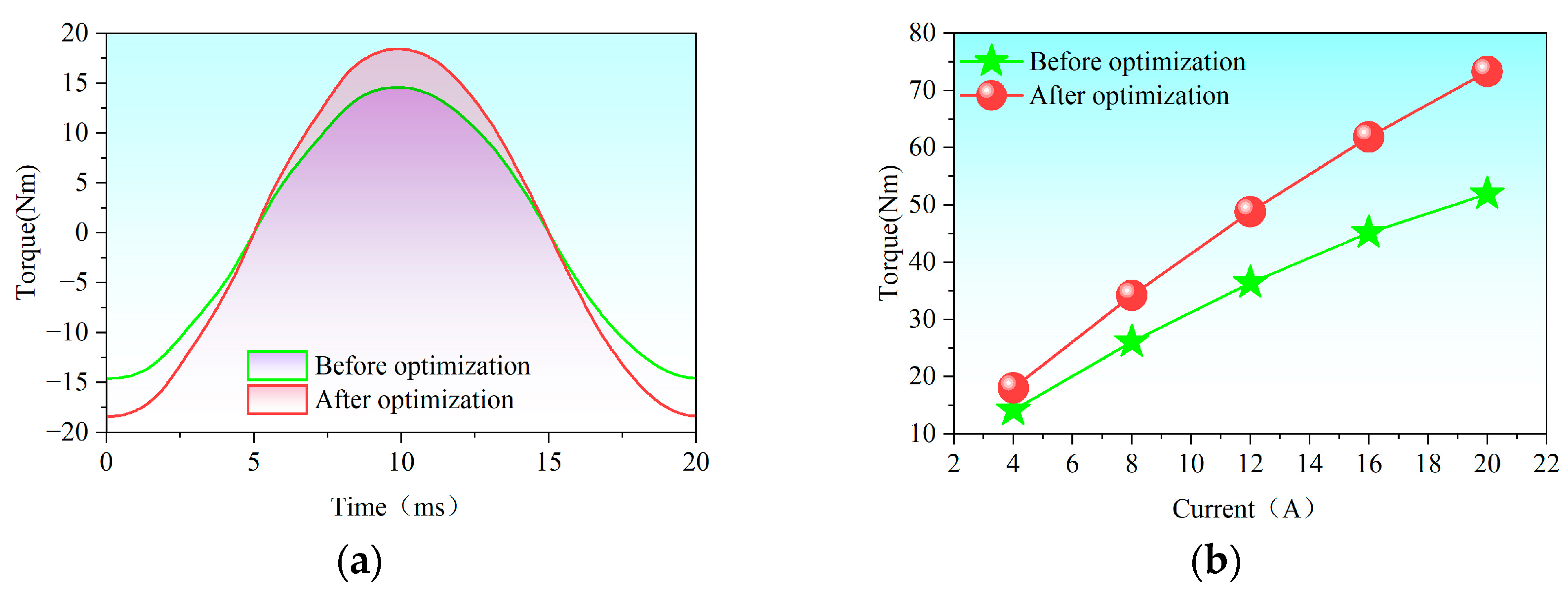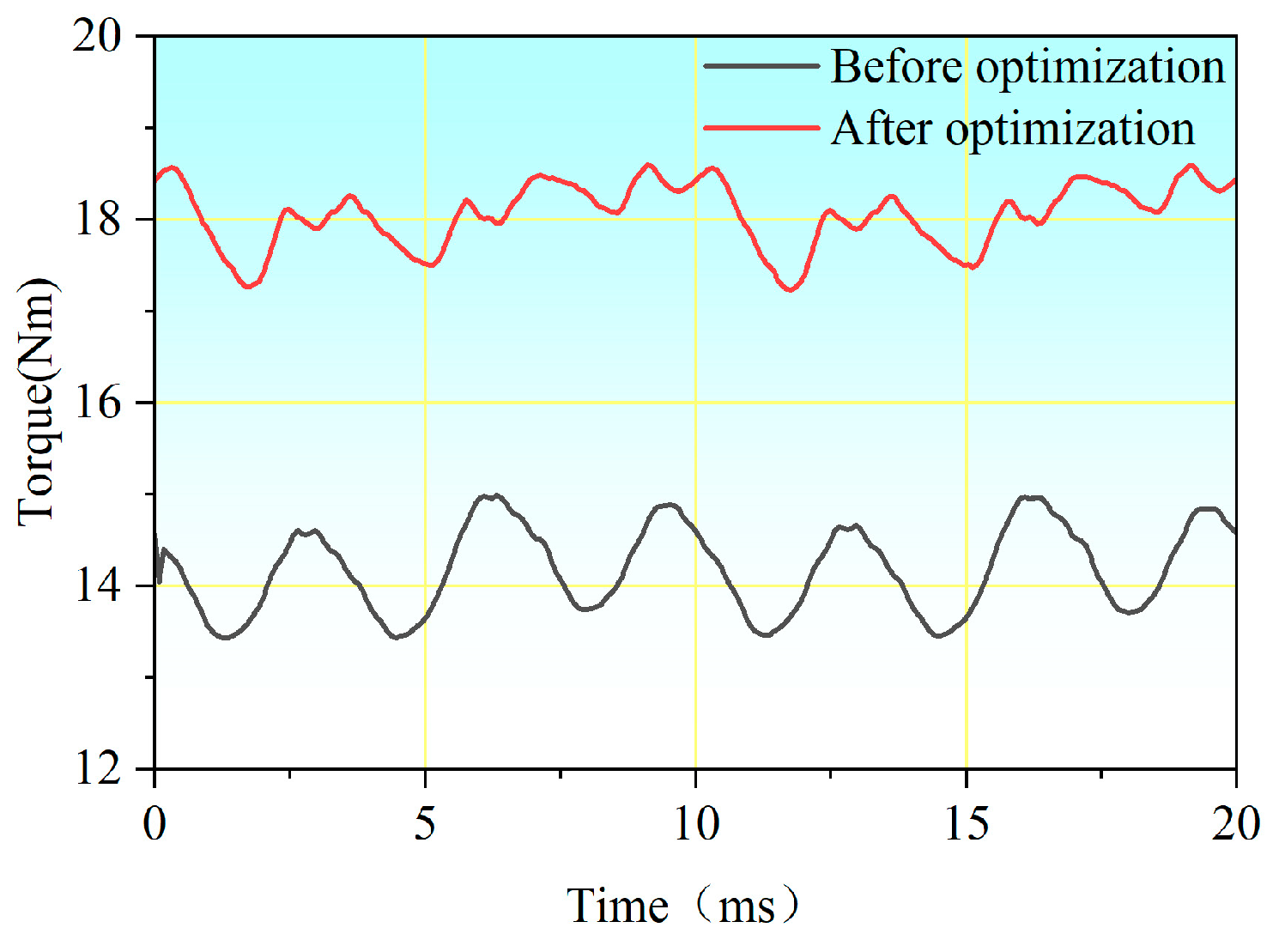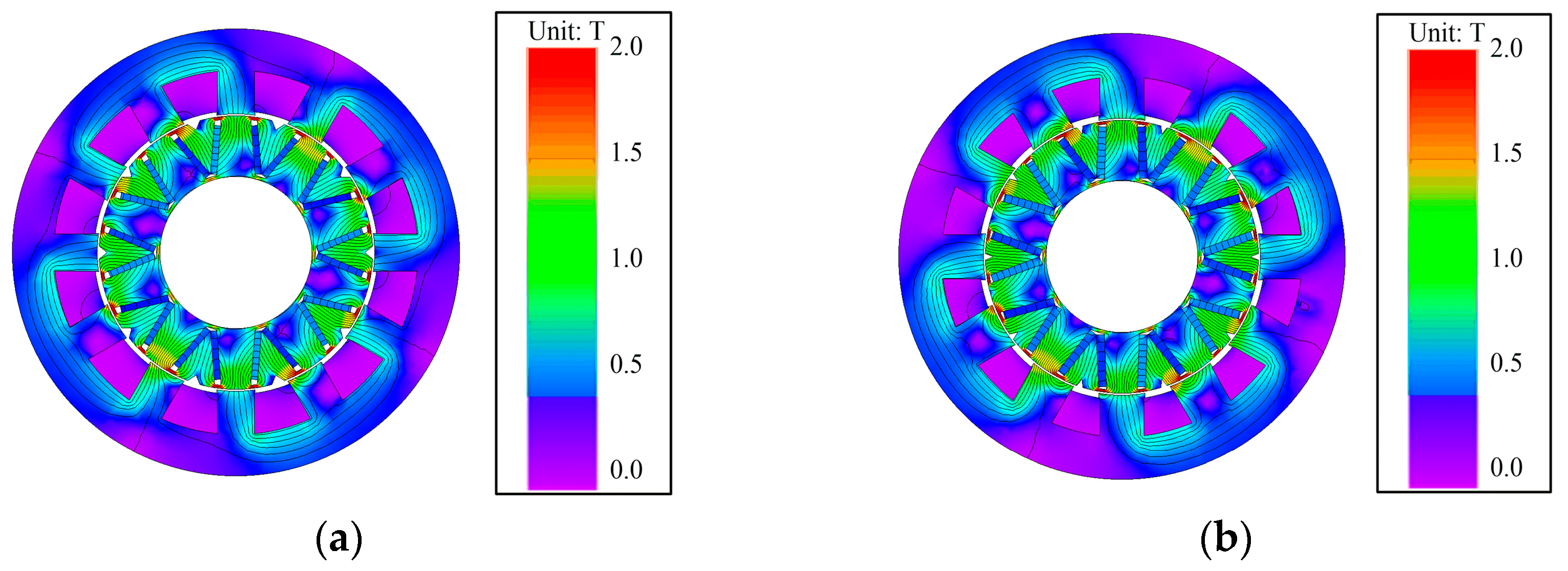1. Introduction
Permanent magnet (PM) motors are extensively used as electromagnetic energy conversion devices in industrial applications and domestic appliances, such as industrial robots, wind power generation, electric vehicles, air conditioning systems, washing machines, and hair dryers. For low-speed high-torque direct-drive applications, PM motors are particularly favored for their high torque density and efficiency, which often eliminate the need for mechanical gearboxes [
1]. Among PM motor topologies, the permanent magnet vernier motor (PMVM) stands out for its exceptional torque density, operational reliability, and efficiency, making it suitable for low-speed direct-drive scenarios [
2]. However, despite these advantages, PMVMs also have some shortcomings, such as high iron losses due to rich harmonic fields [
3], significant cogging torque [
4], potential risks of PM demagnetization under severe operating conditions [
5], and relatively low power factor [
6], which necessitates careful design and optimization [
7].
The working principle of the PMVM is based on the field modulation effect (FME) [
8], which allows the design of the pole-pair number (PPN) of the armature windings to differ from the PPN of the rotor magnets, while also enabling torque generation by harnessing rich magnetic field harmonics. Recent research efforts have focused on improving the electromagnetic performance of PMVMs through developing novel topologies or optimizing existing ones. For example, Ref. [
9] designed a surface-mounted PMVM to make a good compromise between torque density and power factor through constructing closed-form per-unit equations. Ref. [
10] proposed a five-phase fault-tolerant interior PMVM for high reliability and high torque density at low speed. Ref. [
11] designed and analyzed a consequent-pole PMVM to reduce PM material cost, cancel even-order harmonics, and achieve high torque density. Ref. [
12] proposed a new PMVM with both yoke PMs and slot PMs on stator for torque enhancement. Ref. [
13] developed and analyzed a V-shaped PMVM with dummy slots in the rotor for reducing flux leakage, enhancing the output torque, and suppressing the torque ripple. Ref. [
14] presented a novel fractional-slot H-shaped PMVM to enhance torque density and decrease cogging torque. Ref. [
15] designed a special L-shaped PMVM to reduce the leakage flux lines in the end portion of the PMs, which enhanced flux linkage and power factor. Ref. [
16] proposed a novel design of PMVM with a T-shaped consequent pole rotor, which can increase fundamental airgap flux density, PM utilization ratio, and output torque. Ref. [
17] presented a PMVM with saddle-shaped PMs to improve torque and reduce torque ripple. Ref. [
18] designed and analyzed two five-segment Halbach-array PMVMs with two different slot/pole combinations to achieve a high torque density with an acceptable power factor, while maintaining a low torque ripple. Ref. [
19] developed a spoke-array PMVM with magnets bridge, which can effectively restrict the flux barrier effect and improve electromagnetic performance. Ref. [
20] proposed a spoke-type PMVM with an unaligned stator auxiliary teeth arrangement to significantly enhance the field modulation effect, back-electromotive force (Back-EMF), and electromagnetic torque. Ref. [
21] explored a consequent-pole K-shaped PMVM, which has the advantages of spoke- and V-shaped magnetic arrangements. Ref. [
22] proposed a PMVM with coding-shaped teeth, which can introduce permeance harmonics with a specific phase and amplitude to ensure that modulating flux fields contribute to the torque output. Ref. [
23] developed a PMVM with an unequal stator modulated teeth structure to reduce electromagnetic vibration. Ref. [
24] proposed a straight-tooth PMVM with Halbach-array magnets in a stator slot opening to improve Back-EMF and power factor. Ref. [
25] comparatively analyzed two split-tooth PMVMs with evenly and unevenly distributed modulation teeth, and the results verify that the PMVM with unevenly distributed modulation teeth outperforms the one with evenly distributed modulation teeth. Ref. [
26] developed a consequent-pole PMVM with an uneven distribution of armature teeth and fault tolerant teeth to generate asymmetric airgap field distribution, improve its working harmonics, and reduce PM consumption. Ref. [
27] explored a PMVM with specially designed stator auxiliary teeth, which can achieve higher torque density than that of a regular nonoverlapping winding PMVM with the same magnet usage. Ref. [
28] proposed a V-shaped PMVM with unequal-width stator slots for cogging torque and torque ripple suppression, while the desired torque output capability is maintained. Ref. [
29] designed and analyzed a PMVM with an asymmetric-stator-pole configuration, which introduces the consequent-pole structure, auxiliary slots, Halbach array, and overhang structure to improve the PM utilization and torque density. In terms of optimization, Ref. [
30] employed a multi-objective genetic algorithm to optimize the V-shaped PMVM, enhancing torque density and reducing torque ripple. Ref. [
31] was devoted to identifying the optimal pole ratio of a spoke-type PMVM by equivalent magnetic circuit model. Ref. [
32] efficiently and accurately optimized a spoke-type PMVM by leveraging multi-level sensitivity analysis, approximate model, and multi-objective genetic algorithm to enhance torque density and power factor. Ref. [
33] optimized a spoke-type PMVM accounting for eccentric pole-arc shape by an analytical method. Ref. [
34] used a novel numerical model to optimize the output torque, torque ripple, efficiency, and power factor of a PMVM.
Cogging torque remains a critical electromagnetic performance in PM machines, including PMVMs. Several techniques have been developed to mitigate cogging torque. For instance, Ref. [
35] comprehensively reviewed skewing techniques for cogging torque suppression in permanent magnet synchronous motors (PMSMs), including continuous skew, step skew, and notch skew. Ref. [
36] comprehensively investigated and evaluated the cogging torque suppression techniques of flux-switching permanent magnet machines, such as skewing stator, skewing rotor, step-skewing rotor, asymmetric stator and rotor structures, the successively shifting and alternately shifting rotor teeth techniques, pairing rotor, chamfering, and tooth notching. Ref. [
37] adopted auxiliary slots on the rotor to minimize the cogging torque of V-type interior PMSMs. Ref. [
38] proposed a method to reduce cogging torque in PM machines by shifting the elementary-cogging unit. Ref. [
39] designed, analyzed, and fabricated a fully coreless axial-flux PM generator for eliminating cogging torque and eddy current losses, enhancing efficiency. Ref. [
40] pointed out that cogging torque can be mitigated by increasing the least common multiple of the slot–pole combinations. Refs. [
41,
42] presented tooth-shaping methods to reduce the cogging torque of axial-flux PM machines. Refs. [
43,
44] minimized cogging torque by designing proper magnet shapes. Ref. [
45] applied a magnet-shifting design for a PMVM to reduce cogging torque as well as torque ripples. Ref. [
46] employed the design of non-uniform tooth distribution in PMVM to reduce cogging torque and enhance output torque.
Another notable issue in PMVMs is iron loss, which tends to be higher due to the rich harmonic content resulting from the field modulation effect. Several methods have been proposed to reduce iron loss, including material selection, lamination design, structural design or optimization, and control strategies. For example, Ref. [
47] selected amorphous magnetic material effectively as a stator core material and adopted the lamination design. Ref. [
48] pointed out that D-axis flux barrier design can effectively alleviate the PM loss and core loss in fractional-slot PMVMs. Ref. [
49] stated that adjusting the slot shape or introducing a flux barrier can suppress stator core loss. Ref. [
50] proposed various stator modular design schemes with different slot–pole combinations to mitigate the losses in fractional-slot PMVMs. Ref. [
51] presented the segmented stator design for the PMVM to achieve low loss. Ref. [
52] employed the hybrid stator design for a fault-tolerant PMVM to improve its performance, including low core losses. Ref. [
53] designed a new rotor structure based on the rotor losses production principle to suppress rotor losses. Ref. [
54] developed a harmonic-analysis-based loss minimization method incorporated into model predictive torque control for efficiency improvement.
It can be inferred from the existing research above that developing new topologies to improve the electromagnetic performance of PMVMs remains a key focus. Inspired by the V-shaped PMVM and auxiliary tooth technology, a permanent magnet vernier motor with rotor auxiliary teeth (denoted as “RAT-PMVM”) is proposed by introducing rotor auxiliary teeth (RAT) into a V-shaped PMVM, with the purpose of enhancing overall performance. Based on the proposed RAT-PMVM, we comparatively study the influence of the number, position, and tooth profile of the RAT on the electromagnetic performance of the RAT-PMVMs, revealing superior performance in the RAT-PMVM with trapezoidal teeth (denoted as “TT-PMVM”). Finally, multi-objective optimization of the TT-PMVM is conducted to minimize torque ripple while enhancing torque, power factor, and efficiency. The innovation of this paper lies in proposing a new topology for the RAT-PMVM, which serves as a viable solution for low-speed direct-drive applications like industrial robots and wind power generation. The primary contribution of this work is that, through a comparative analysis of the impact of the number, position, and tooth profile of the RAT on the electromagnetic performance of the RAT-PMVMs, the TT-PMVM is identified as the optimal topology for its superior overall performance.
6. Multi-Objective Optimization
The foregoing results demonstrate that the TT-PMVM achieves enhanced Back-EMF, output torque, efficiency, and power factor through comparatively analyzing the influence of the number, position, and profile of rotor auxiliary teeth. However, the TT-PMVM suffers from large torque ripples. Consequently, a multi-objective genetic algorithm is employed to optimize the TT-PMVM by using JMAG software (Version 23), targeting a simultaneous reduction in torque ripples and enhancement of the output torque, power factor, and efficiency.
Figure 41 illustrates the geometric parameter schematic for multi-objective optimization, while
Table 6 details corresponding parameter ranges.
The optimization objectives are defined as follows:
where
Trip denotes the torque ripple ratio,
Tave represents average torque,
EFF signifies efficiency, and
PF indicates power factor.
The expression of
Trip [
58] is the following:
The expression of
Tave [
59] is the following:
The expression of
EFF [
60] is the following:
where
corresponds to the mechanical angular speed of the rotor;
represents the copper loss;
represents the total iron loss;
represents the permanent magnet hysteresis loss.
The expression of
PF [
61] is the following:
where
E0 denotes the RMS value of Back-EMF;
represents the RMS value of phase current;
Ra signifies the per-phase winding resistance;
corresponds to the mechanical angular speed of the rotor;
Lq stands for
q-axis inductance.
Figure 42 illustrates the procedure for multi-objective optimization employed in the JMAG software (Version 23). First, the optimization objectives are set as torque ripple ratio, average torque, efficiency, and power factor, as expressed in Equation (11). The optimization variables are defined as the geometric parameters listed in
Table 6. Next, the key task is to establish a parametric simulation model in JMAG software (Version 23). The optimization objectives are configured according to Equation (11), and the variation ranges of the geometric parameters are set based on
Table 6. Then, the genetic algorithm is selected in JMAG for optimization. Afterwards, the optimization process is executed, once all configurations are completed. Finally, the results are analyzed to determine the optimal solution.
Figure 43 presents the optimization results for TT-PMVM. The result indicated by the red arrow satisfies the optimization objectives defined in Equation (11). Consequently, the corresponding geometric parameters are selected as the optimal configuration for TT-PMVM, as listed in
Table 7. As can be seen from the table, the value of
R1 has been reduced to 0.9 mm after optimization. Such a small distance may pose a challenge for the high-precision assembly of future prototypes.
Figure 44 compares the Back-EMF of the TT-PMVM at 300 rpm before and after optimization. The optimized waveform in
Figure 44a exhibits increased amplitude. Corresponding harmonic spectra in
Figure 44b demonstrate reduced THD from 13.5% to 11.9%.
Figure 45 compares torque performance of TT-PMVM before and after optimization.
Figure 45a displays the blocking torque curve during one electrical cycle under locked-rotor conditions (0 rpm) and rated current (I = 4 A). Clearly, the optimized TT-PMVM exhibits increased torque output capability.
Figure 45b illustrates the average torque versus current characteristics of TT-PMVM before and after optimization. As the current increases, the optimized TT-PMVM generates higher average torque.
Figure 46 compares the rated output torque of the TT-PMVM before and after optimization. The optimized TT-PMVM demonstrates a 27.3% increase in average torque (14.19 Nm → 18.06 Nm), while the torque ripple ratio decreases by 31.8% (11.0% → 7.5%).
Figure 47 and
Figure 48 display the magnetic field distribution and current density distribution of the TT-PMVM before and after optimization under rated conditions, respectively. As can be seen from
Figure 47, the saturation level of the TT-PMVM under rated conditions is comparable before and after optimization. However, by comparing the number of leakage flux lines at the stator slots, it is observed that the leakage flux is reduced after optimization. As can be seen from
Figure 48, the maximum current density of the optimized motor does not exceed 4 A/mm
2 under rated conditions. Thus, the steady-state temperature rise remains within acceptable limits after optimization.
Table 8 compares the other electromagnetic performances of the TT-PMVM before and after optimization. Beyond output torque enhancement and torque ripple reduction, the efficiency (
EFF) of the optimized TT-PMVM increases from 92.2% to 93.0% (+0.8%), while the power factor (
PF) improves from 0.73 to 0.81 (+11.0%).


